Spotted a Robin for Christmas
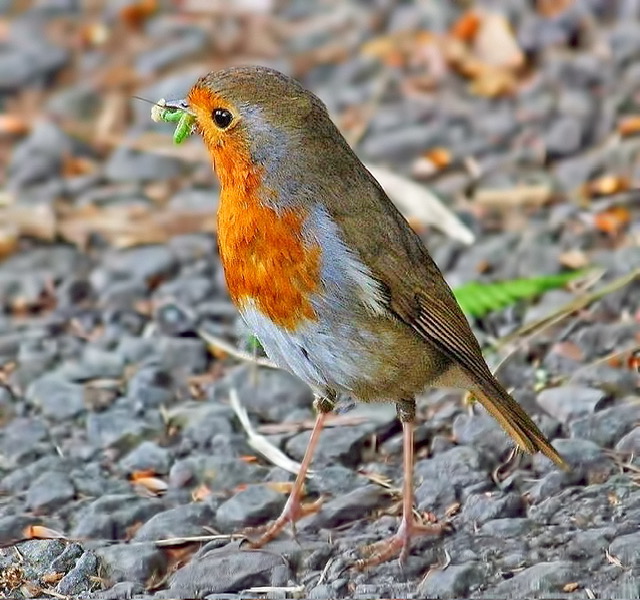
.
Ruth Davies, (Mike’s daughter) ,spotted this robin and sent us this super photo
I

.
Ruth Davies, (Mike’s daughter) ,spotted this robin and sent us this super photo
I
Part 1
While Carmarthenshire boasts the flattest part of the Wales Coast Path, Pembrokeshire is happy to be the hilliest and the most beautiful. When I look at the map of Wales, I don’t realise how big Pembrokeshire is; it’s the same distance around as from Chepstow to Kidwelly. You can see the story so far on previous posts on Resolven District News, or if you want to see the whole story you can find me on Instagram @jack_walkaholic.

I start at Amroth and walk the 300 km round to St Dogmaels, Cardigan. There are 35,000 feet of elevation to climb during this section, which is about 10 times the height of Snowdon, so I’d better get started.
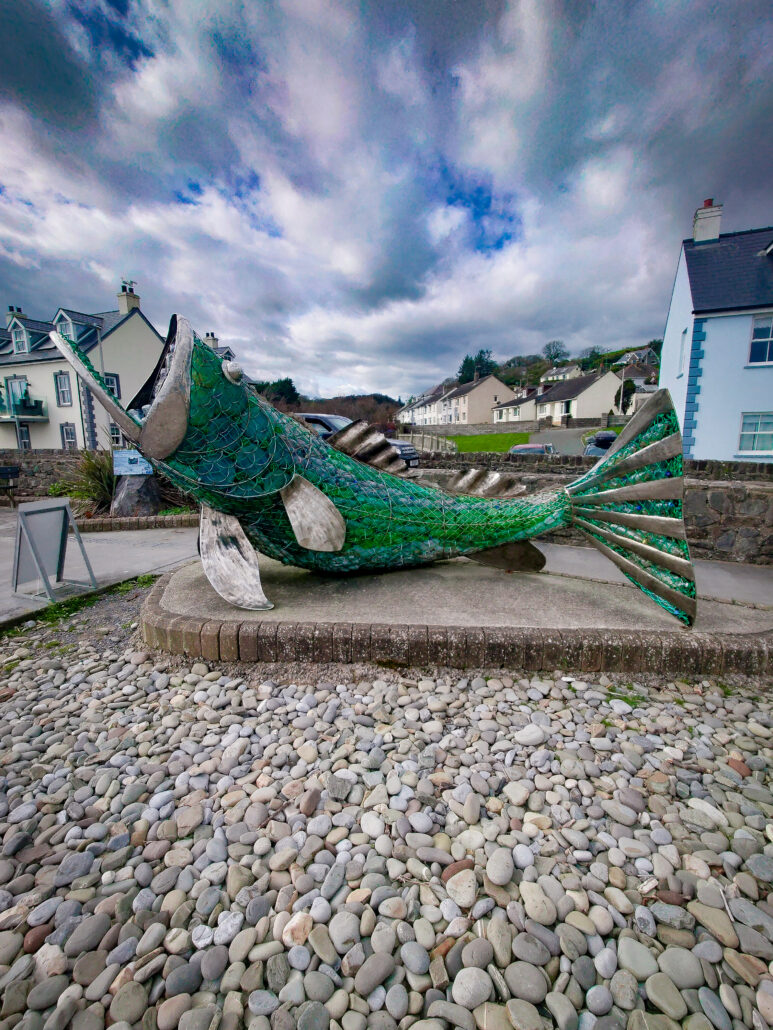
Entering Amroth, it’s a late sunny Sunday afternoon. There are people everywhere. I walk down the main road, dodging the tourists, and back to the safety of the coast, the other end of the village. Up some pretty steep steps and onto a tarmac path. If the whole of Pembrokeshire is like this, I’ll be done in no time. Down into Wisemans Bridge where I finish for the day.
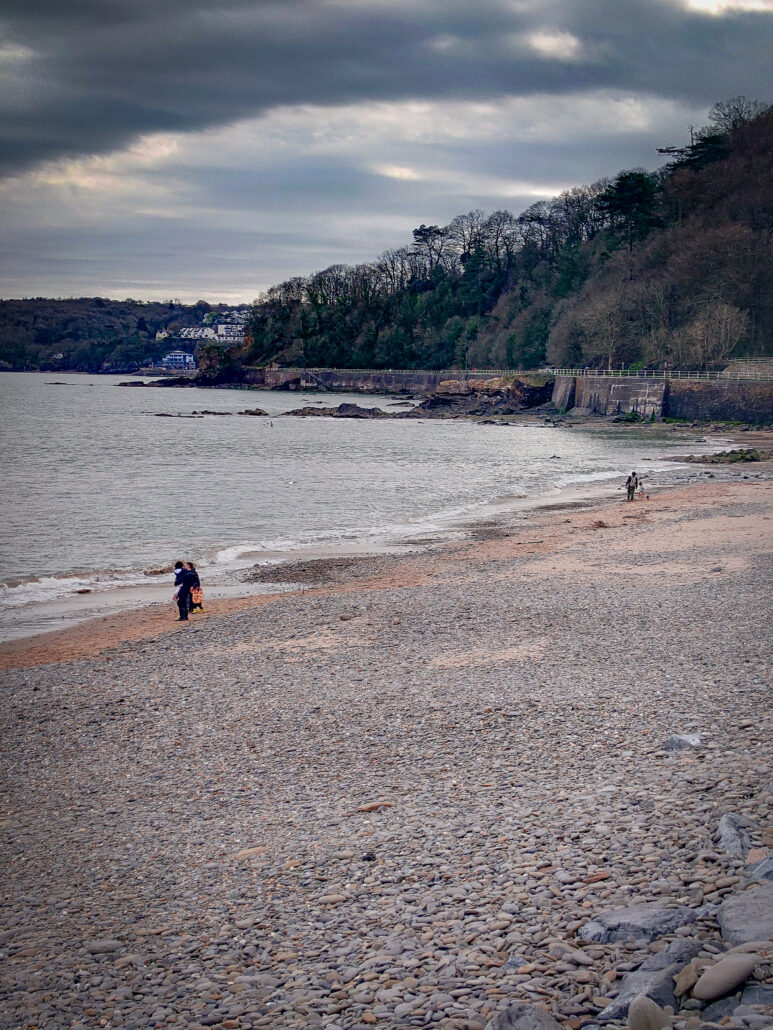
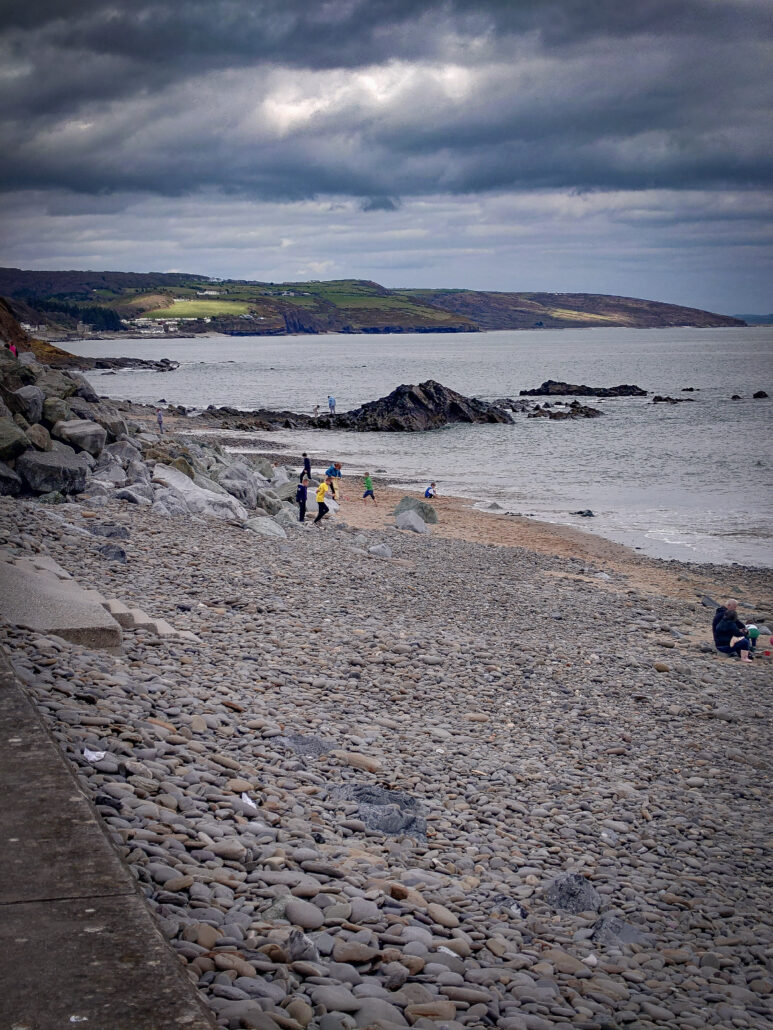
~
Illness meant I lost a few weeks of walking, but I returned to the path a few weeks later. From Wisemans Bridge, there is a tunnel system that goes through to Saundersfoot. Saundersfoot in the early morning is a calm and peaceful place to be. Up the road past the St Brides Hotel, down a lane and into the woods.
It had been raining for weeks and the path through the woods was nothing more than a mud bath. Climbing a slope of mud isn’t the easiest thing to do, taking a step and sliding back a little, every step you take adds more mud to your boot and weight. Along the path, this would be a lovely section if it was dry.
Through a field, over the brow of a hill and as if by magic through the mist is the iconic view of Tenby Harbour. There are a few miles to go before I get there, but the sight of this familiar landscape makes the miles melt away.
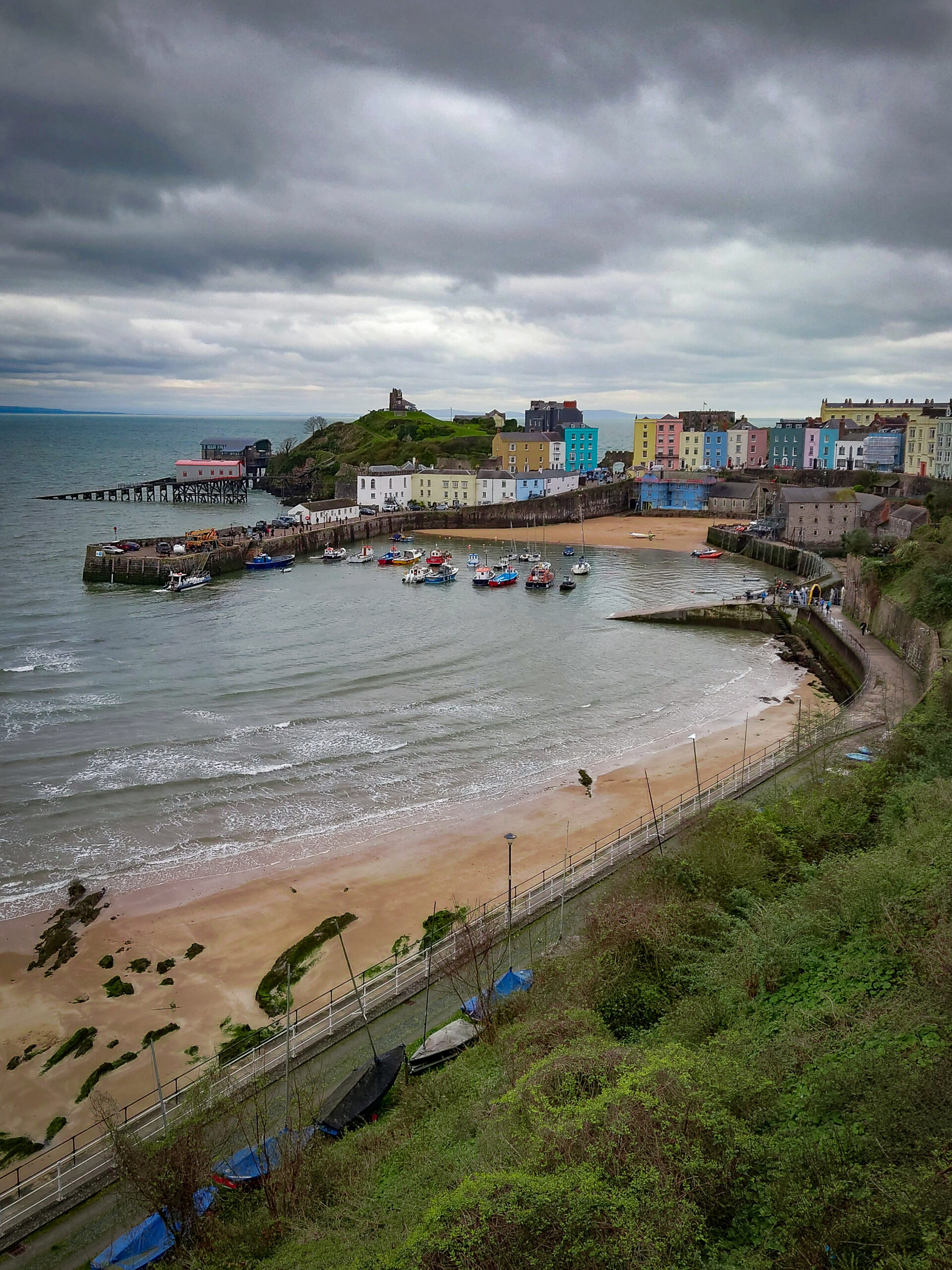
The Coast Path skips around the edge of the town, it misses the Castle, the Tudor Merchants House, the ice cream parlour and it only overlooks the North Beach.
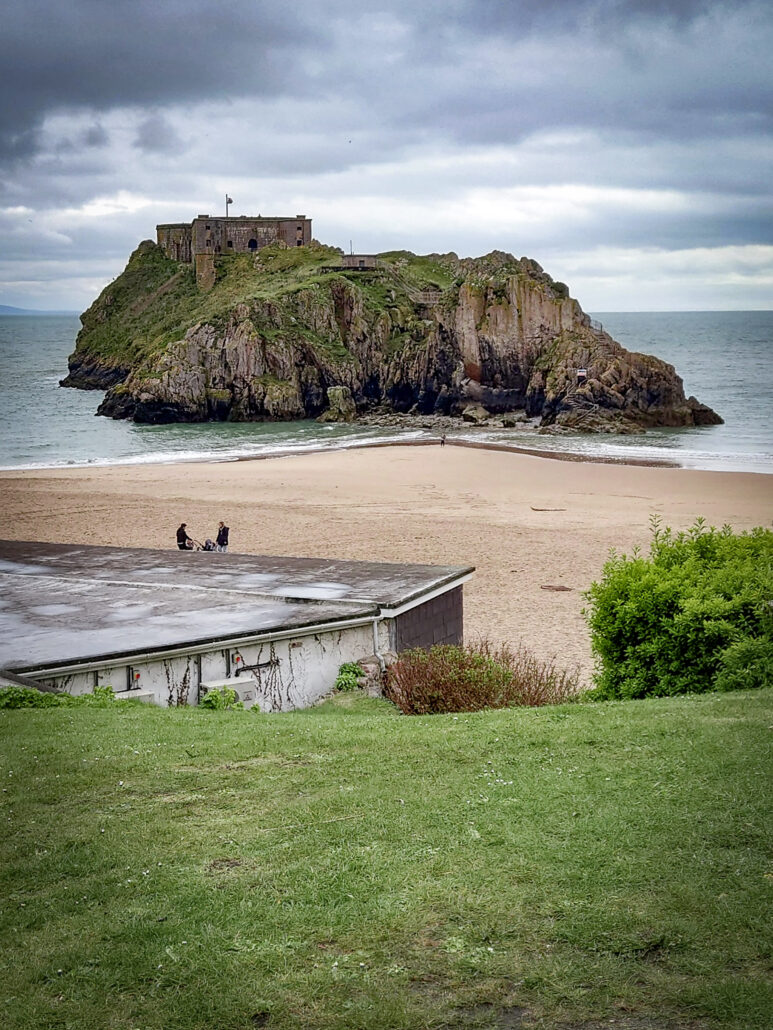
At the end of the Promenade, the path takes the route onto the South Beach and I have a mile walk to Giltar Point, another great view of Tenby and Caldey Island.
The rain and hail start battering me, I’d hoped to be further along before it started, there was lightning forecast and I didn’t want to be on a cliff when that started.
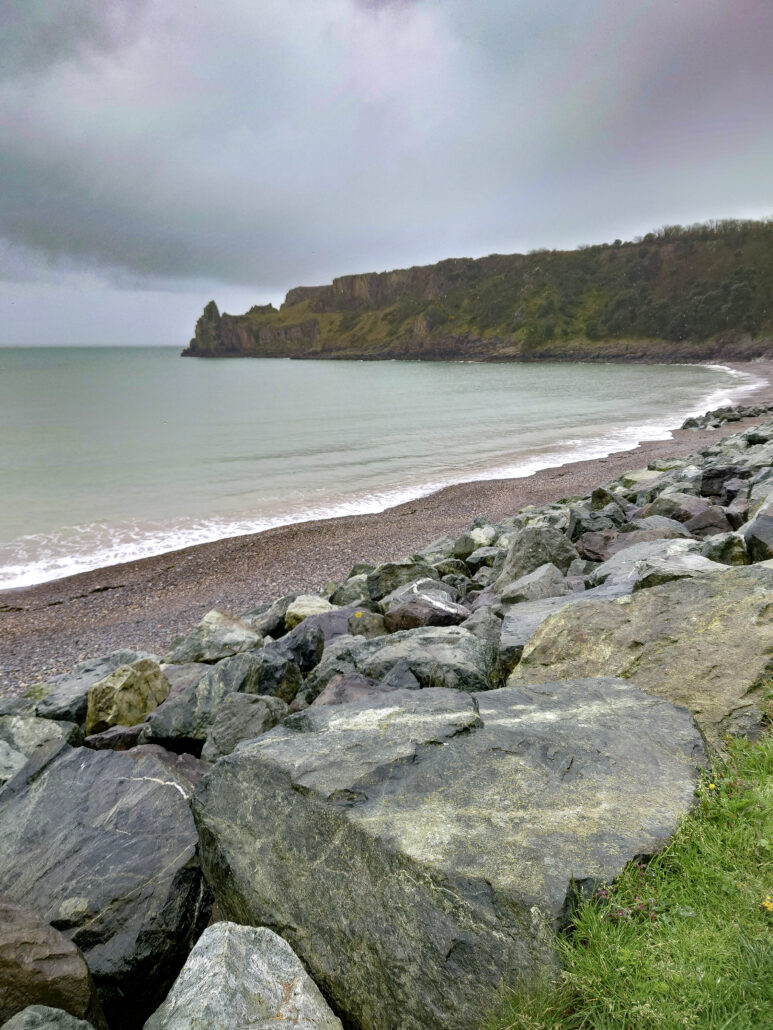
Along to Lydstep, a Haven Resort with a gentle sheltered bay. Up onto Lydstep Point, still no lightning, a walk to one of my favourite places, Church Doors Cove. There’s a steep set of steps down and back up to the path and it’s not part of the route, but since I’m here it would be rude not to go down. The next beach is Shrinkle Haven, a beach with limited access, as the path down to it has been eroded. Around the military base and there’s a small but perfectly formed beach called Presipe. This is a beach the locals use as it’s not as well known as the others in the area. Around the coast I go past a burial chamber called Kings Quoit and onto Manobier beach, a great bucket and spade beach.
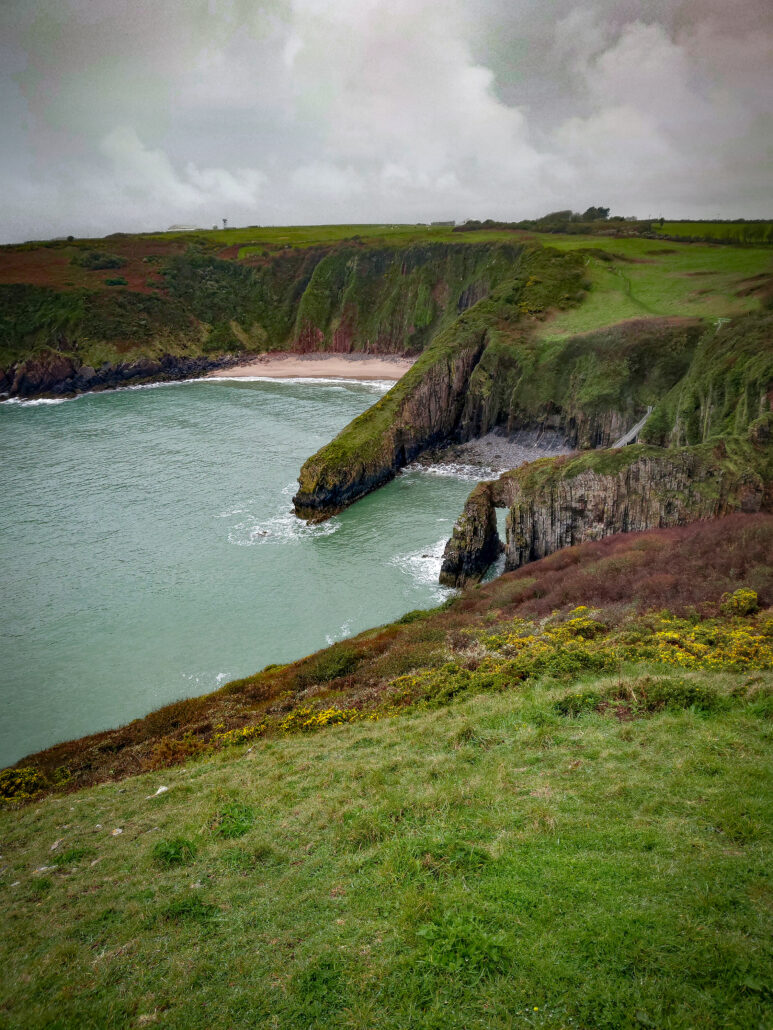
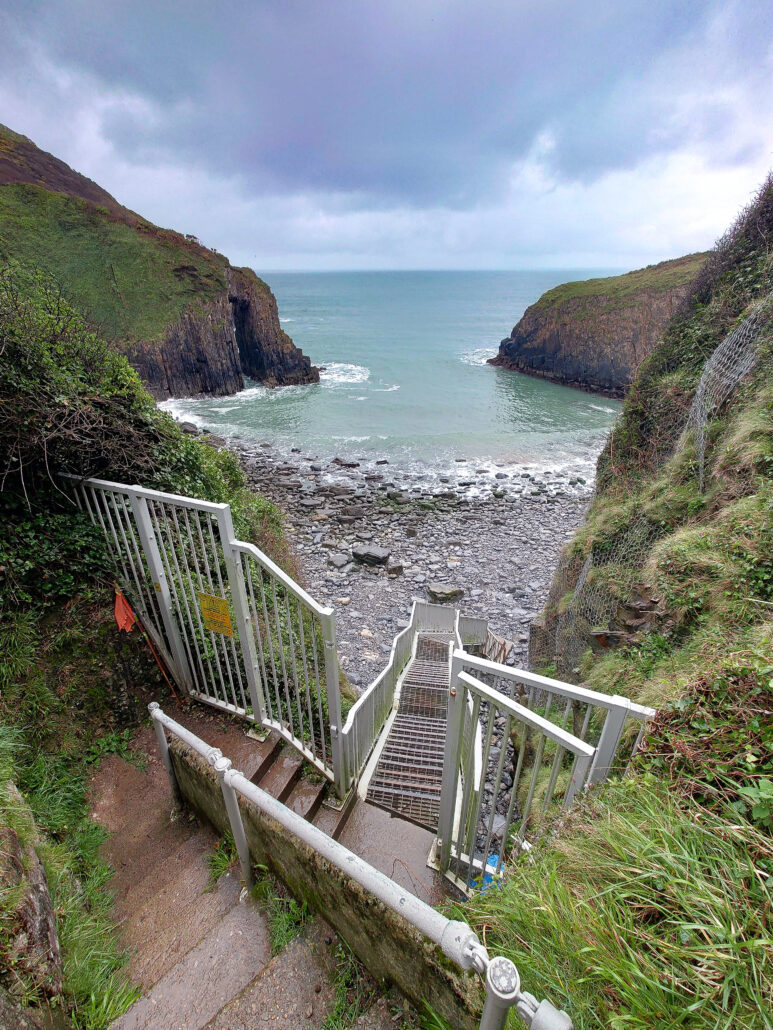

Moving along, the next beach is Swanlake Bay, there’s no easy access to this beach other than the Coast Path, so I have the place to myself and try to dry off from the earlier rain. While looking at the map beforehand, the name intrigued me, this was one of the beaches I was most looking forward to.
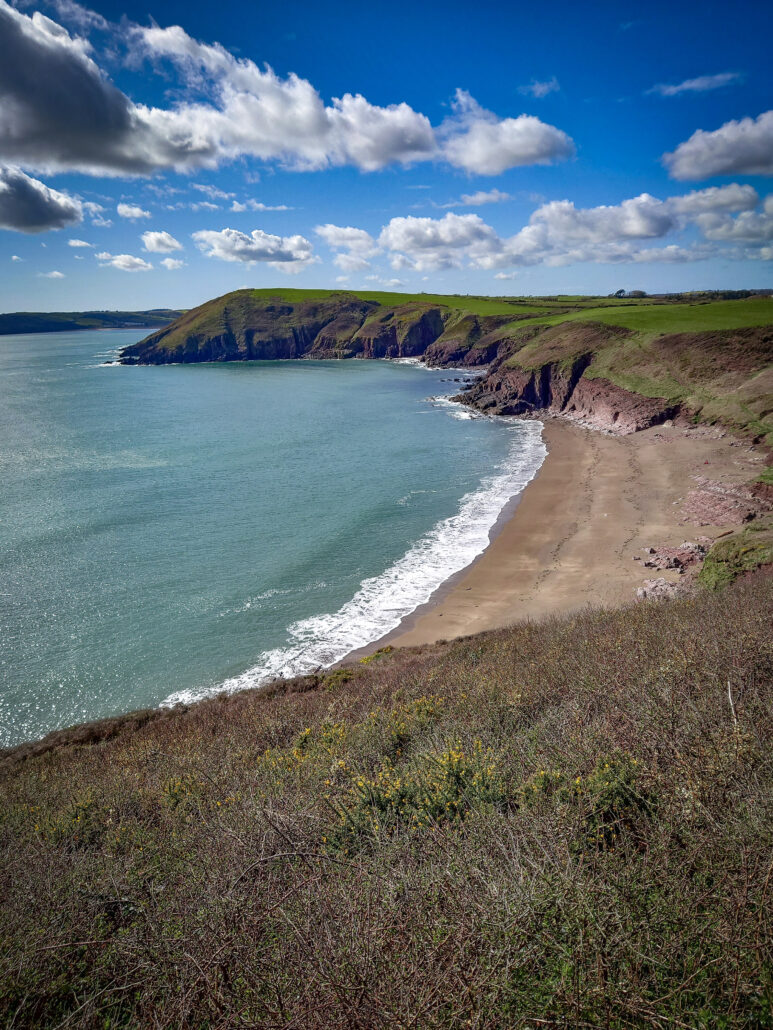
Slightly dryer, I make my way to Freshwater East, the day’s final destination, a tiny village with a beautiful big beach. It’s slightly off the beaten track, and good parking facilities make this a great location for a day trip.
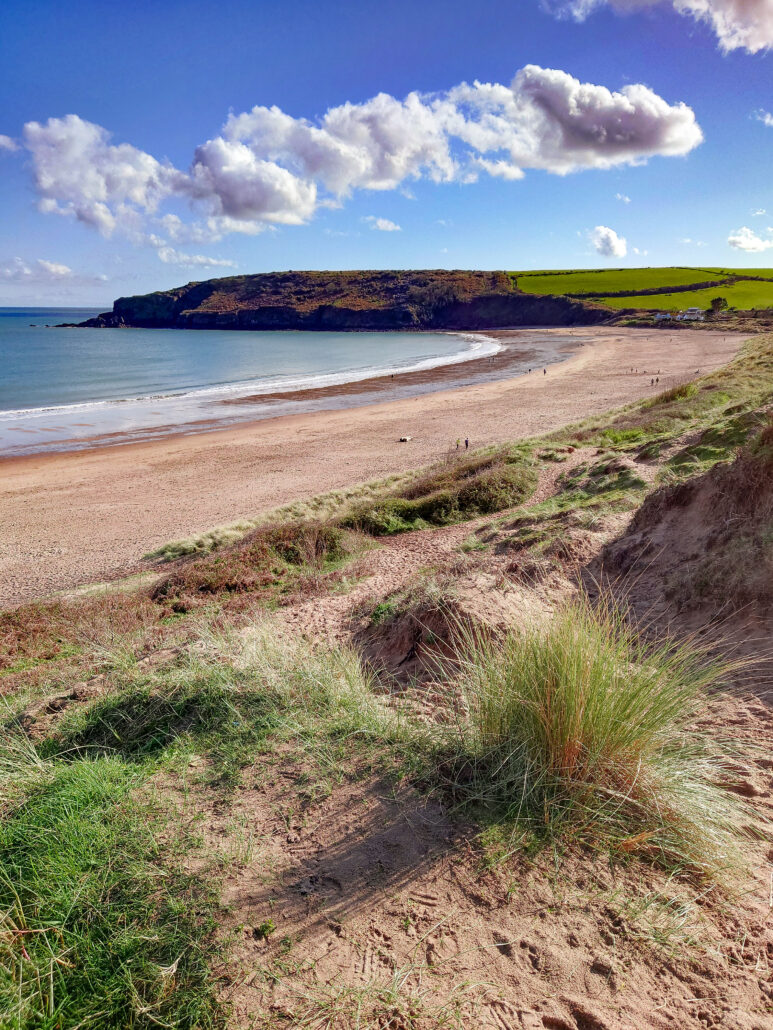
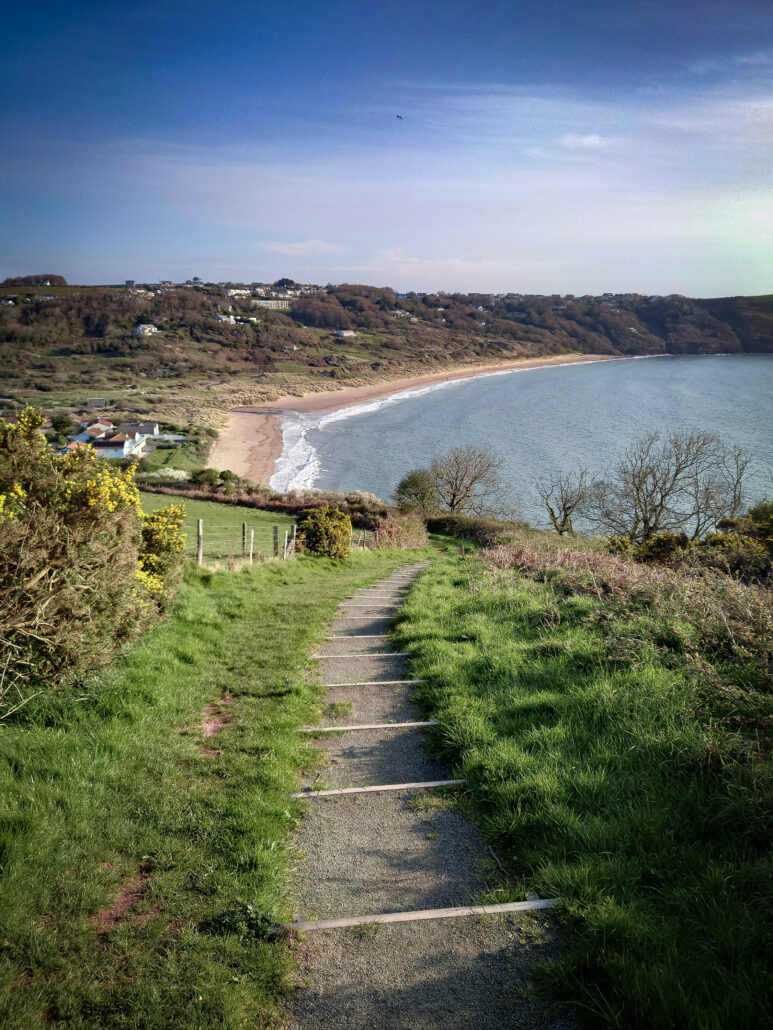
The next day is from Freshwater East to Freshwater West. Leaving Freshwater East, there’s a set of steps that take you up to a nice viewpoint.
The path gently rises and falls from here and stays very close to the cliff edge at times. Pembrokeshire Coast isn’t a National Park because of its beauty, it’s a national park because of the geological formations that run through it. The main colour in the rock faces at the moment is red, but you can see some banding that has been layered through the ages.
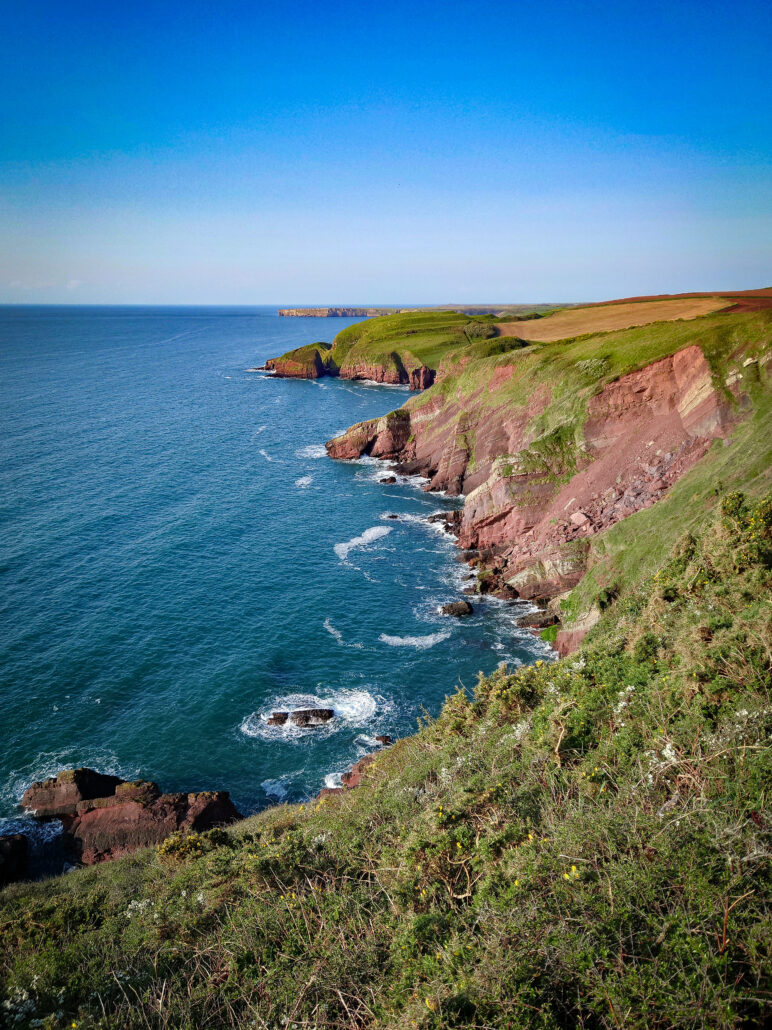
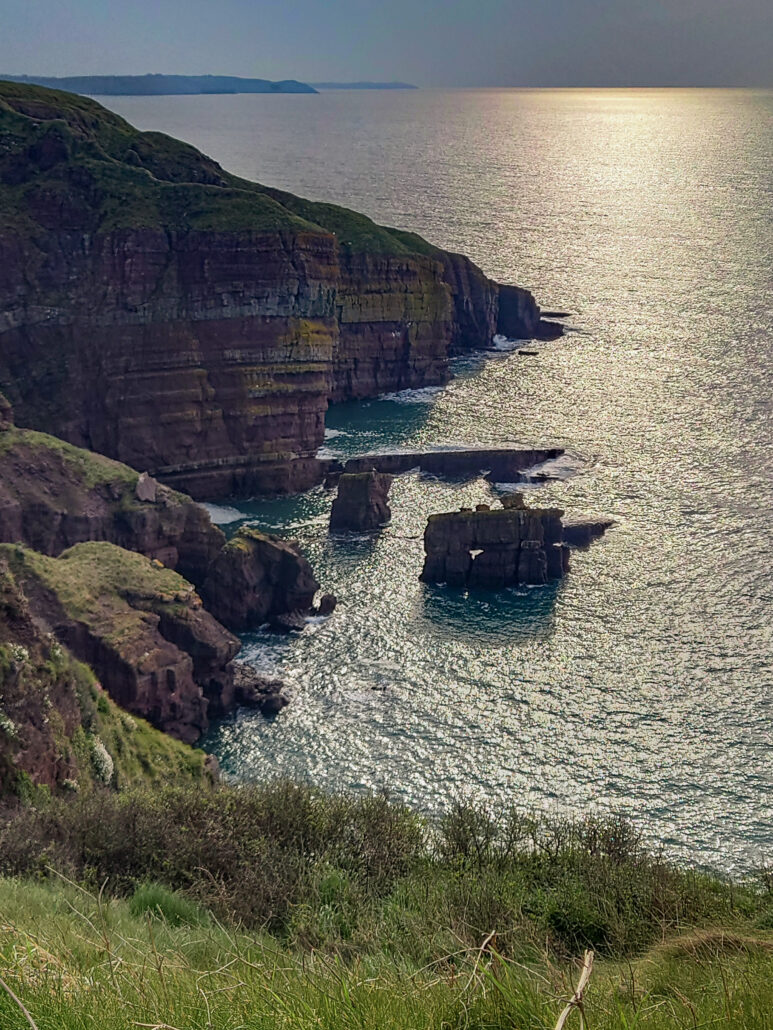
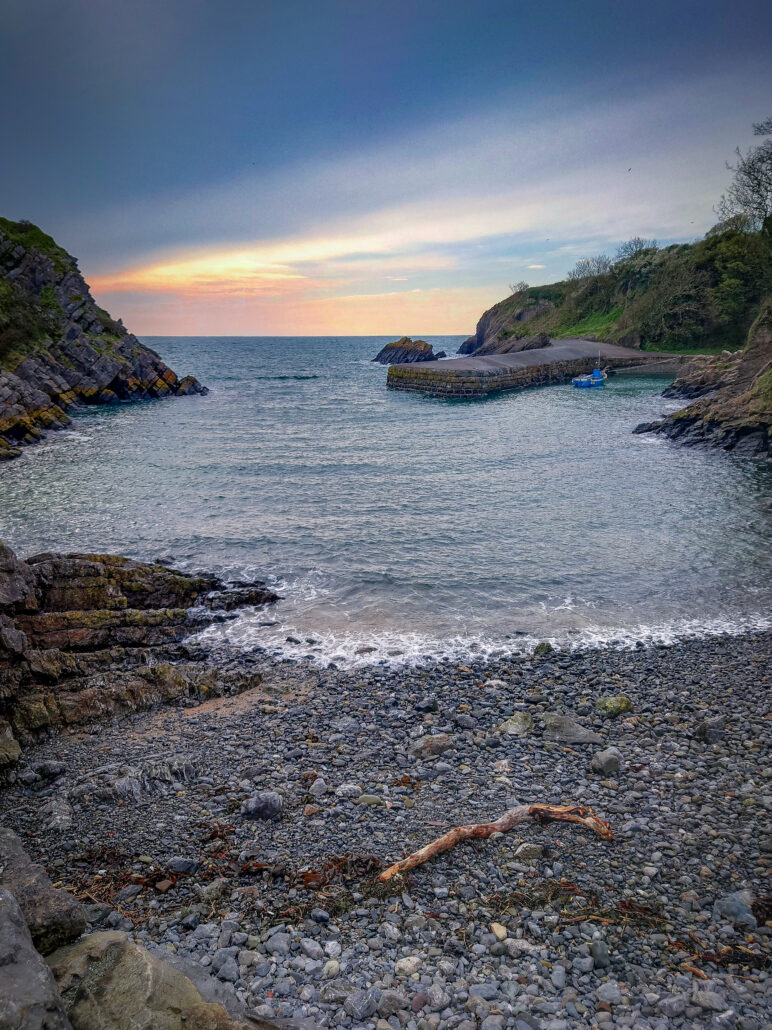
Stackpole Quay is the next place of interest. There is a geological fault here that can be seen by the quay side. Up some steps and over a field, I come to Barafundale Bay, this is one of the most beautiful beaches in Wales and has been used in films. I have the beach to myself, the tide crashes, its clear green-blue water, no other footprints. Just me, the sand, the sea and grey morning sky, highlights of gold where the sun lights the edge of the clouds. I leave, dragging myself along the path, up to a headland, the wind blowing my cobwebs away, some seagulls squawk as I look down at them flying below me.
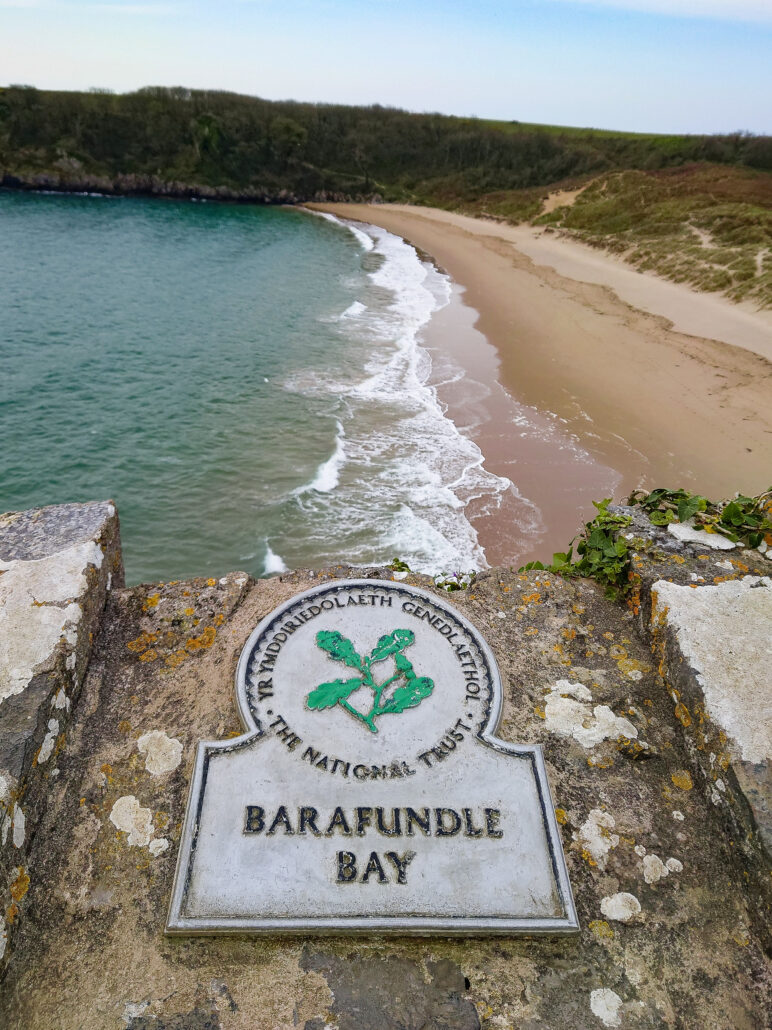

Broad Haven appears, and time for a detour. Bosherston Lakes are here and it’s rude not to have a quick look round whilst I’m here. There are wild birds that will feed from your hand and an otter family, but usually that’s an early morning trip as I see neither this time.
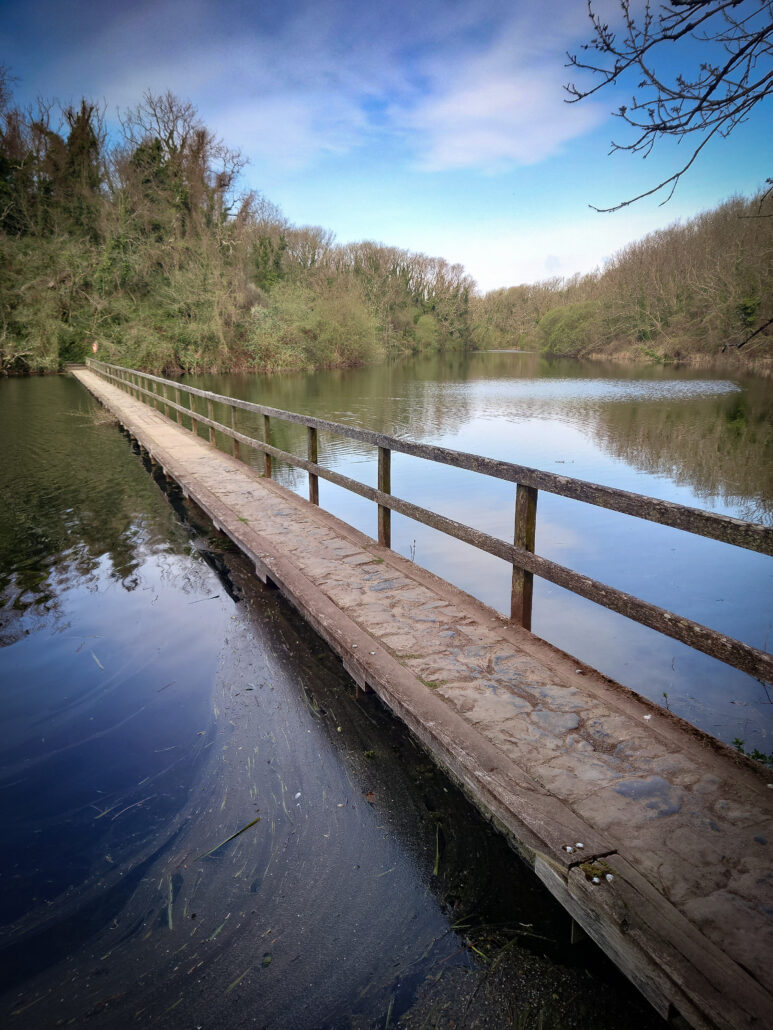
This is where it starts getting tricky, the Coast Path crosses into Castlemartin MOD firing range. Sections are closed off and you have to plan which way you go depending on what’s open on the day you go. Add to it a very poor public transport area, this becomes a source of misery for weeks to a coast path walker. The good news is, I could walk the first section to St Goven’s Chapel, a tiny chapel built into the cliff. The legend here is that if you count the steps down, you’ll never count the same number going back up…. and I didn’t. From here the MOD has closed the range so I have to take an inland route. It goes along the road for a while and into Bosherston, across some fields and alongside the MOD site. Gunfire and all sorts of noise, loud booms and engines growl, the sheep and cows seem unfazed by it all. The worst part of doing this route is, I know what I’m missing on the other Coast Path, Huntsmans Leap, Stack Rocks and the Green Bridge of Wales are all in the 3 mile stretch. Considered to be one of the highlights of the walk, and there’s an army between me and it….. The army wins.
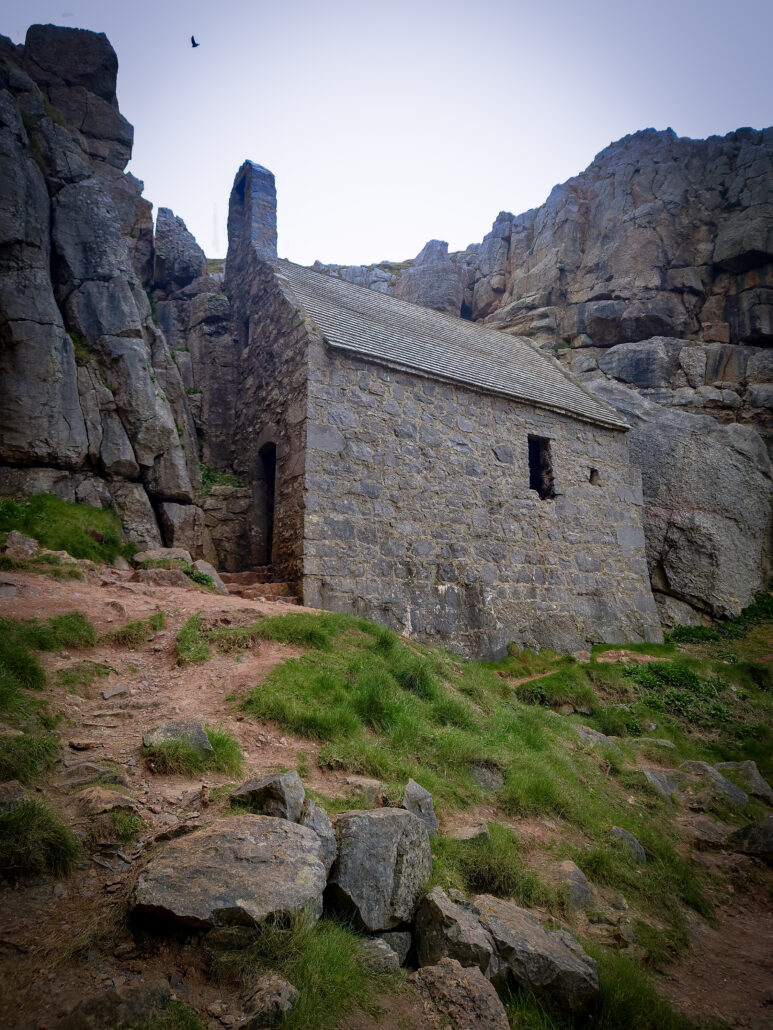
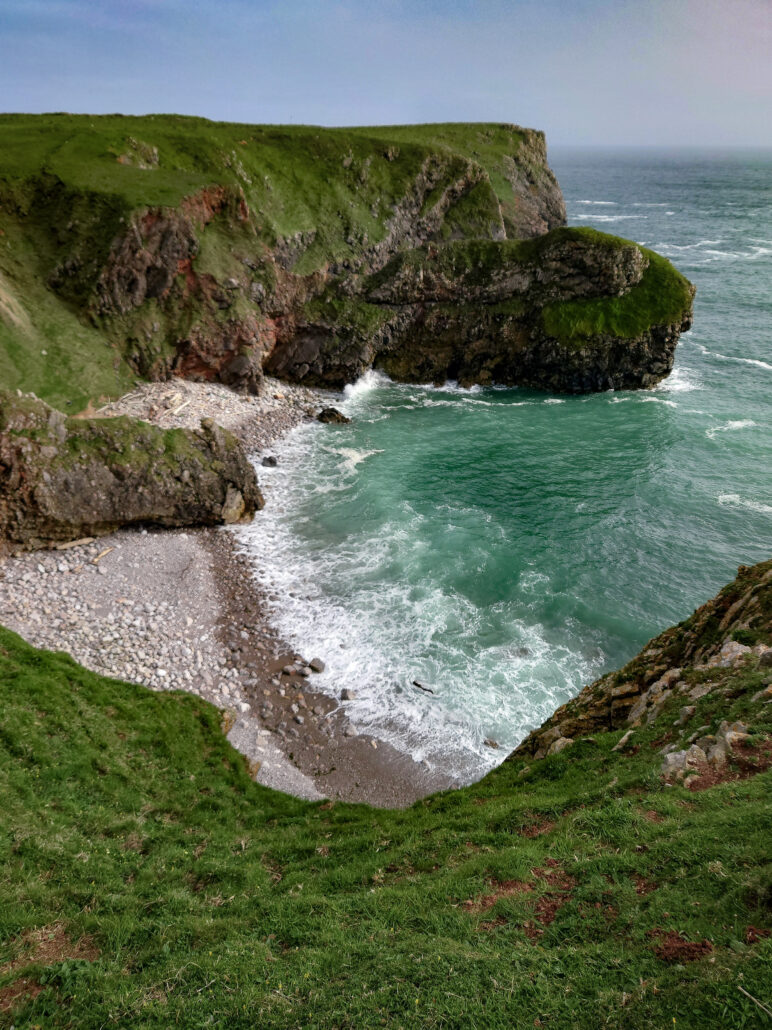
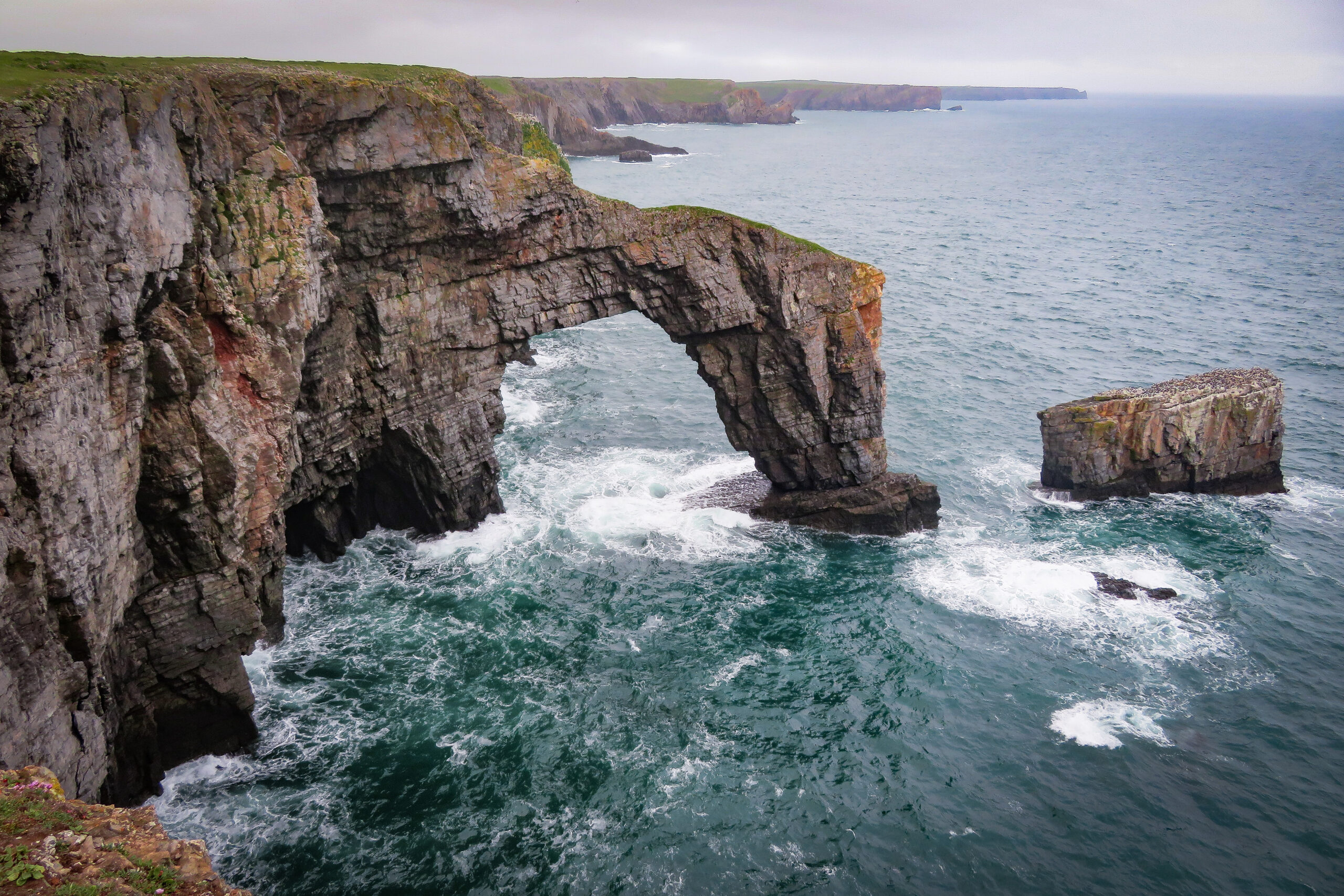

There’s a viewpoint before Castlemartin, you can watch what’s going on, take some binoculars and ear plugs as you’ll need them. On to Castlemartin and my goal for the day, Freshwater West. I remember this beach having quicksand signs on it when I was young, now it’s a beautiful big wave beach that’s popular with surfers.
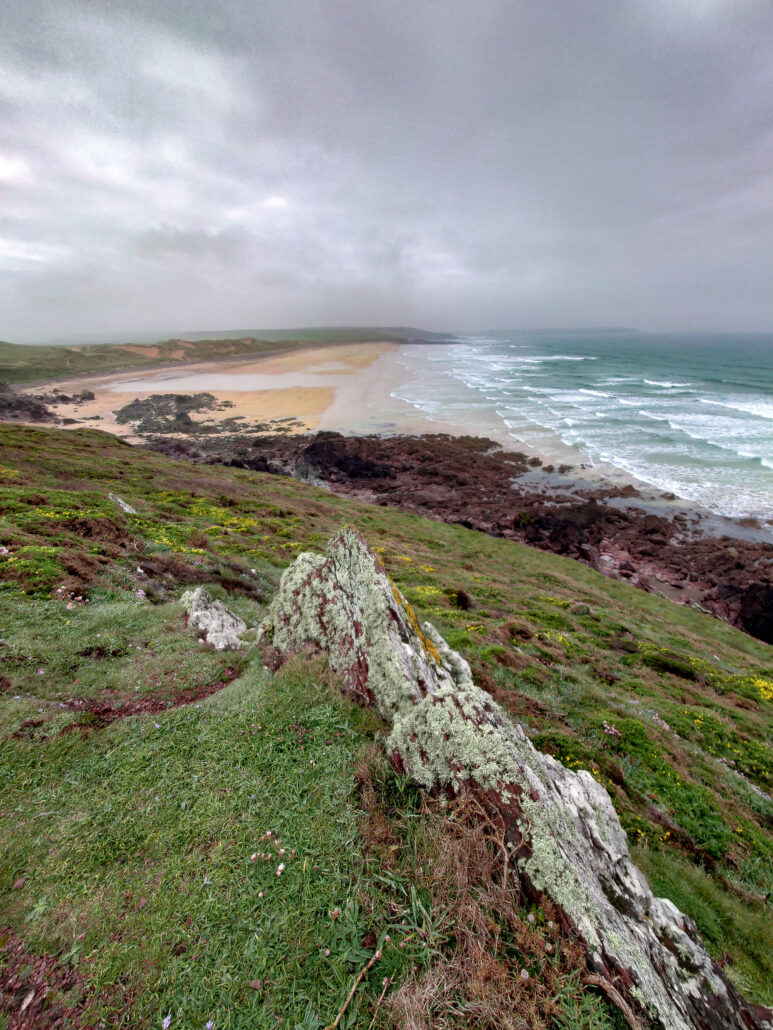
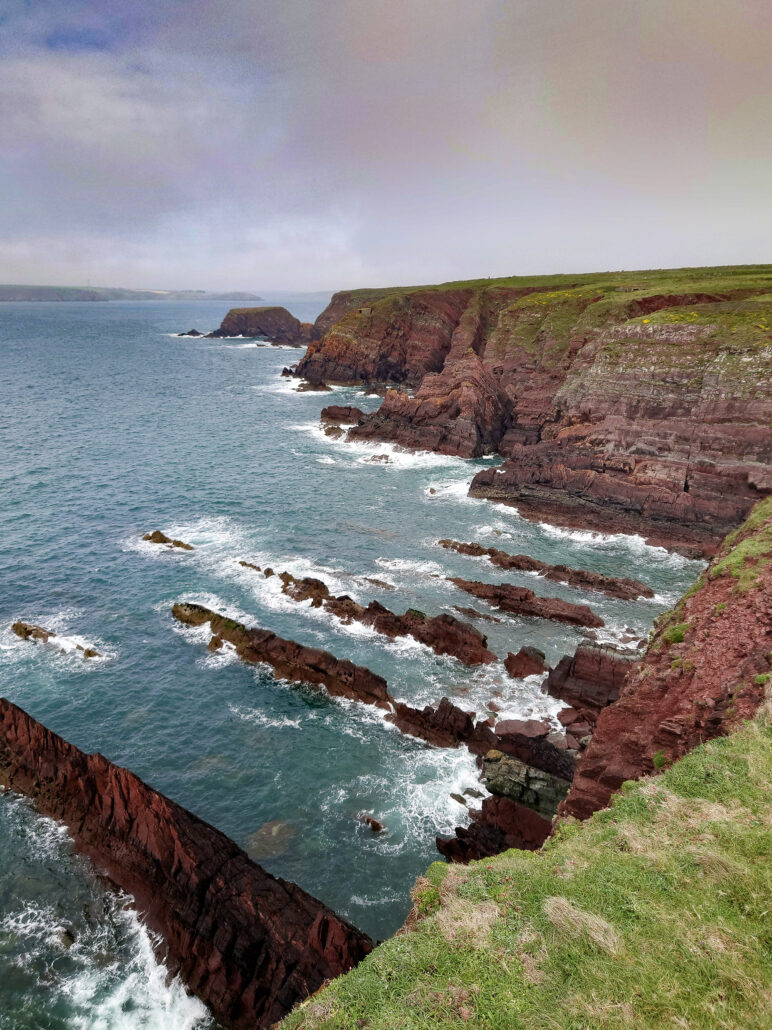
Another day, a thin layer of mist hugs the coast, Freshwater West is a lot longer than I thought, I enjoy watching the dog walkers throw balls for their dogs to chase.
The only sound is the sea, the salty spray refreshing my face as I walk along. Up again, onto a cliff, this is the most remote part I’ve been so far, it’s also one of the nicest parts, I skip along and end up in West Angle Bay before I know it. This is the start of the Milford Haven Waterway, a large natural harbour, formed by a drowned valley from the last ice age.
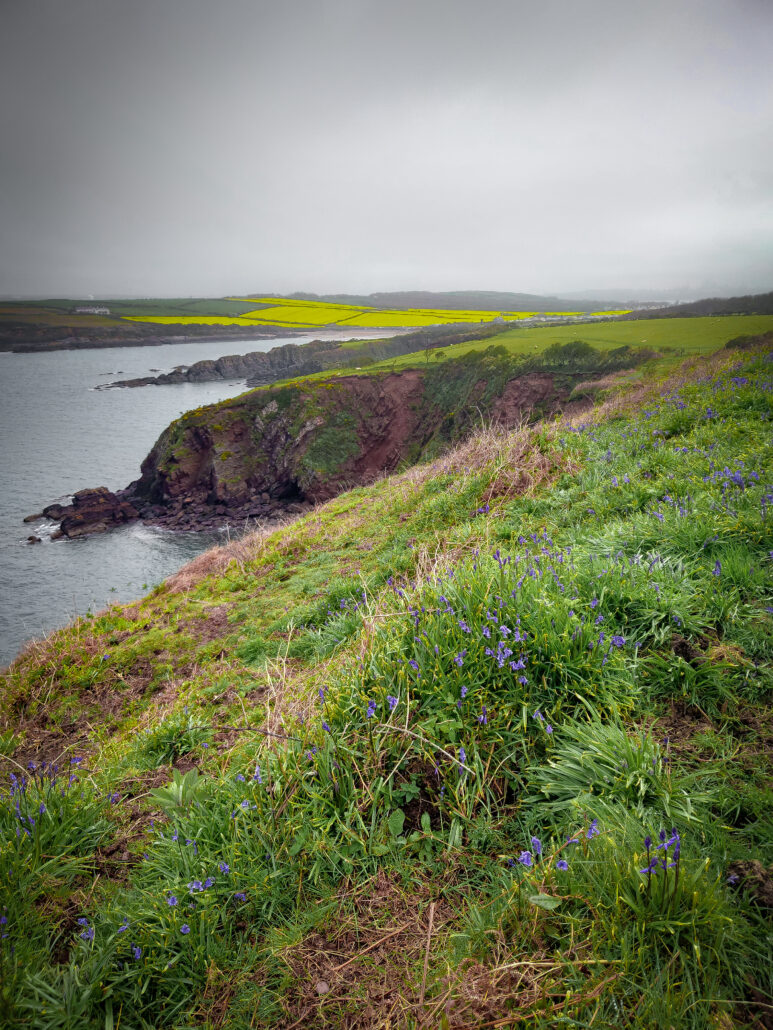
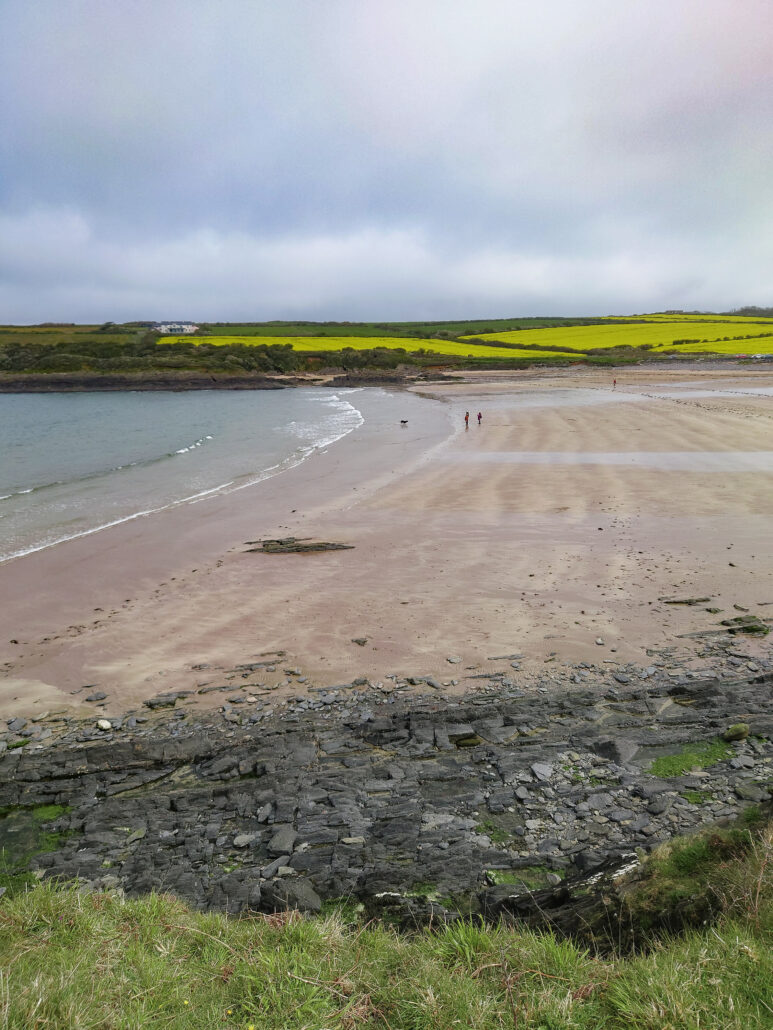
Around to Angle Bay, there’s a lifeboat station, a pub and a tarmac path that goes all the way to the oil refinery. After being out in the sticks for so long, it seems strange to be in such an industrial environment, jetties dominate the Waterway and big chimneys protrude into the sky. However, there’s a lot of green space around, with thick lichen on the trees.
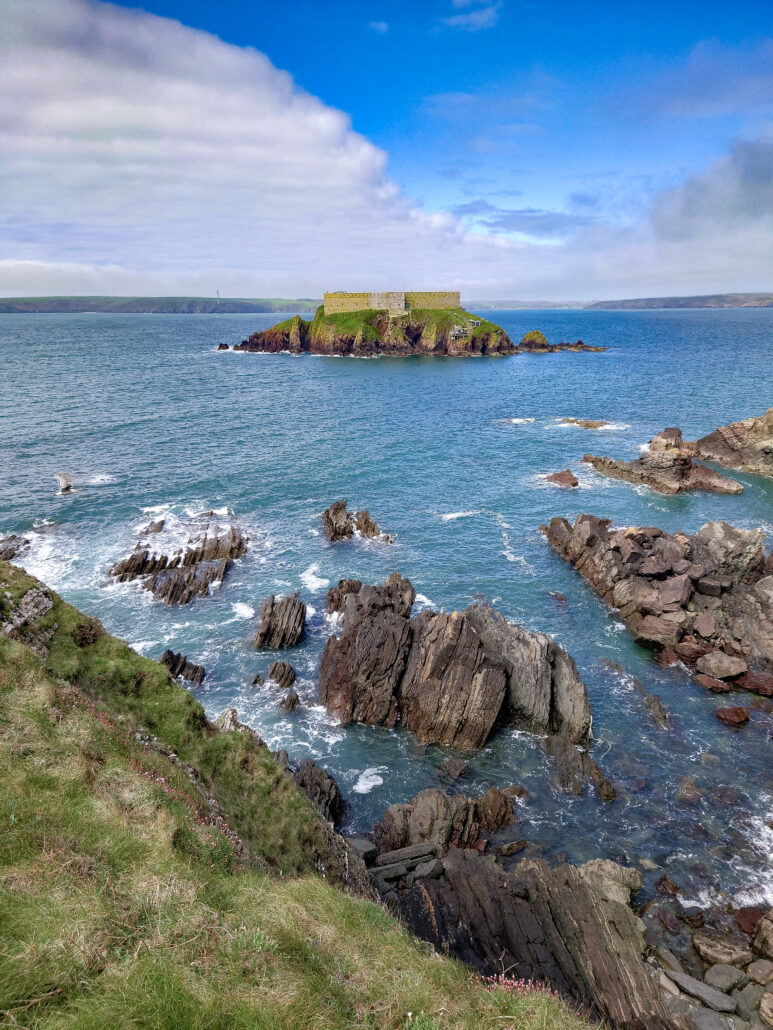
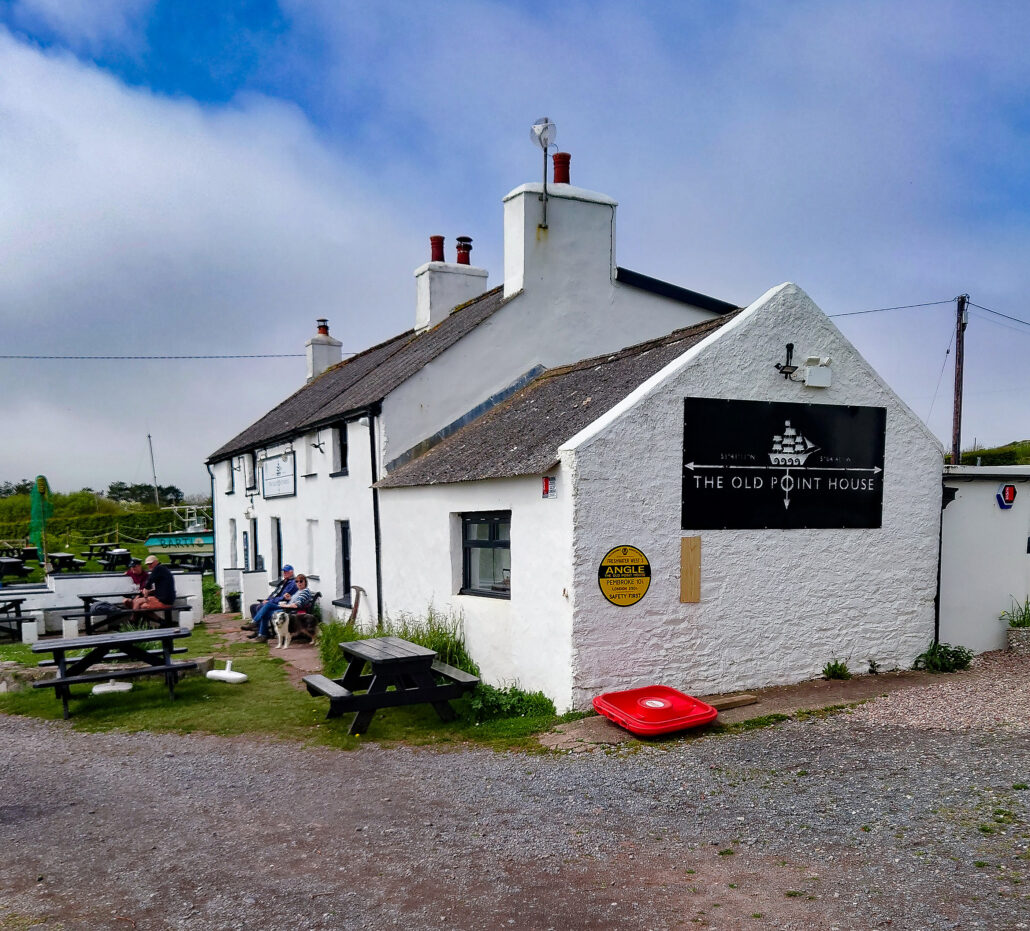
Next to the oil refinery is a power plant, surrounded by green areas. A short walk on a country lane leads to a farmer’s field. How do you feel about cows? My first day on this walk, I almost gave up because of a muddy field and about 20 cows. This time, there are about 50 of them, dairy cows with full udders, bumping against each other, climbing over each other, and blocking the gate. I try to shout and moooove (sorry for the pun) them away, but they don’t budge. My only choice is to return to the road and take a detour. I walk back through the field and I don’t realise there are more cows and a bull in this field. They see me and come running towards me. I look for somewhere to run to, but the mud is too deep and there is nowhere but the gate I came through earlier. I don’t like the look of the bull, but luckily a cow stays between him and me. He pushes her towards me, but she pushes back. Soon I’m at the gate and safe. I backtrack and walk on the road into Pembroke, relieved to be in one piece. That’s where I end my day.
~ ~
End of Part 1 – ‘Jack_Walkaholic in South Pembrokeshire‘
To be continued in Part 2 of ‘Jack_Walkaholic in South Pembrokeshire’ soon
~ ~ ~ ~


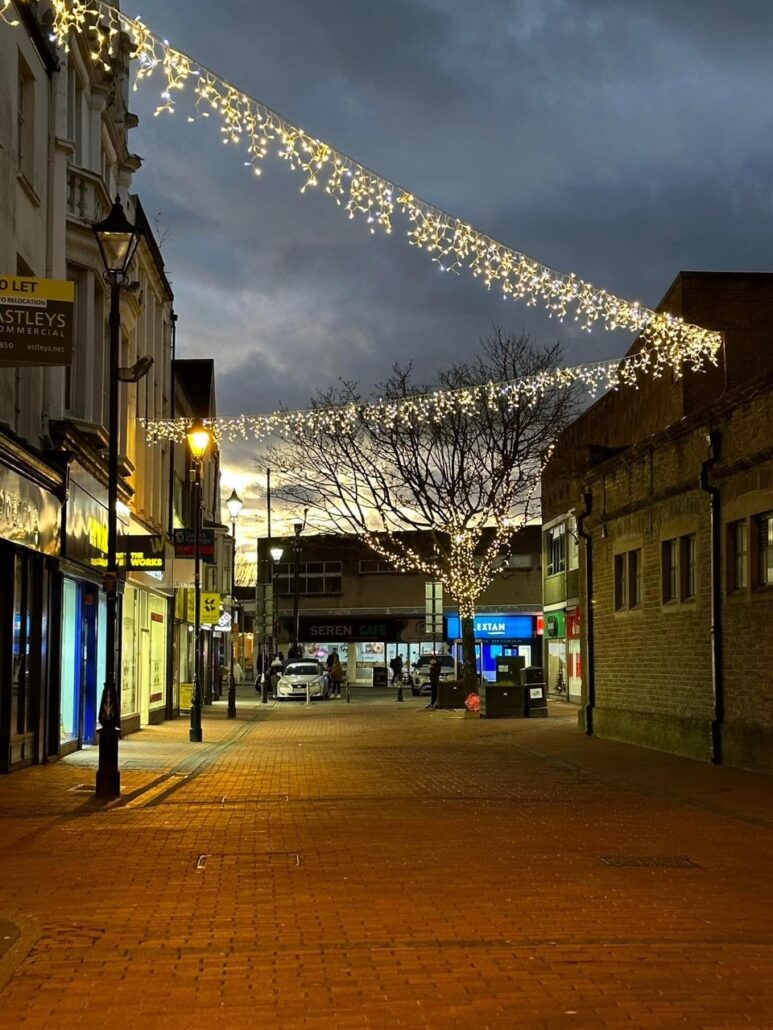
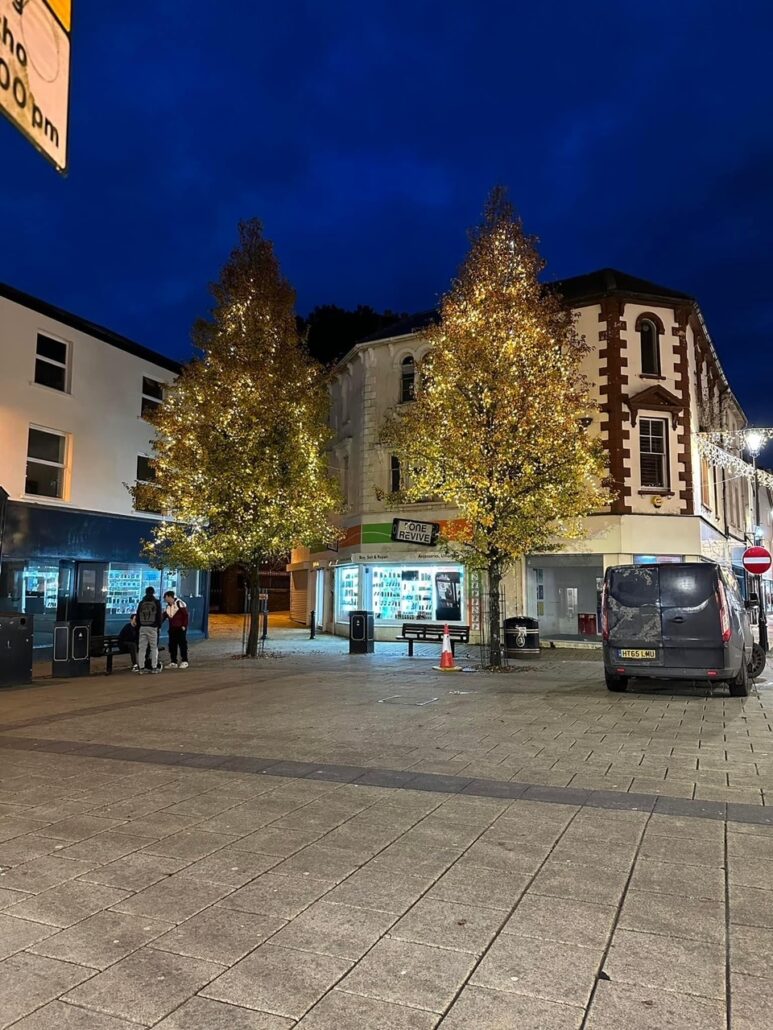

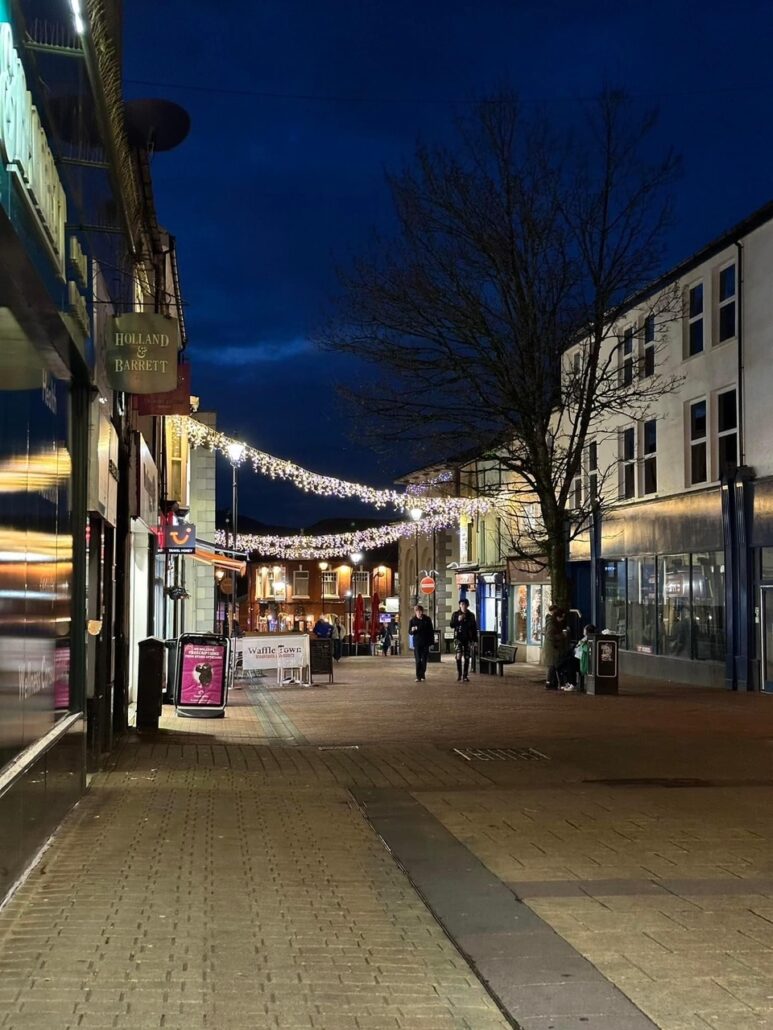

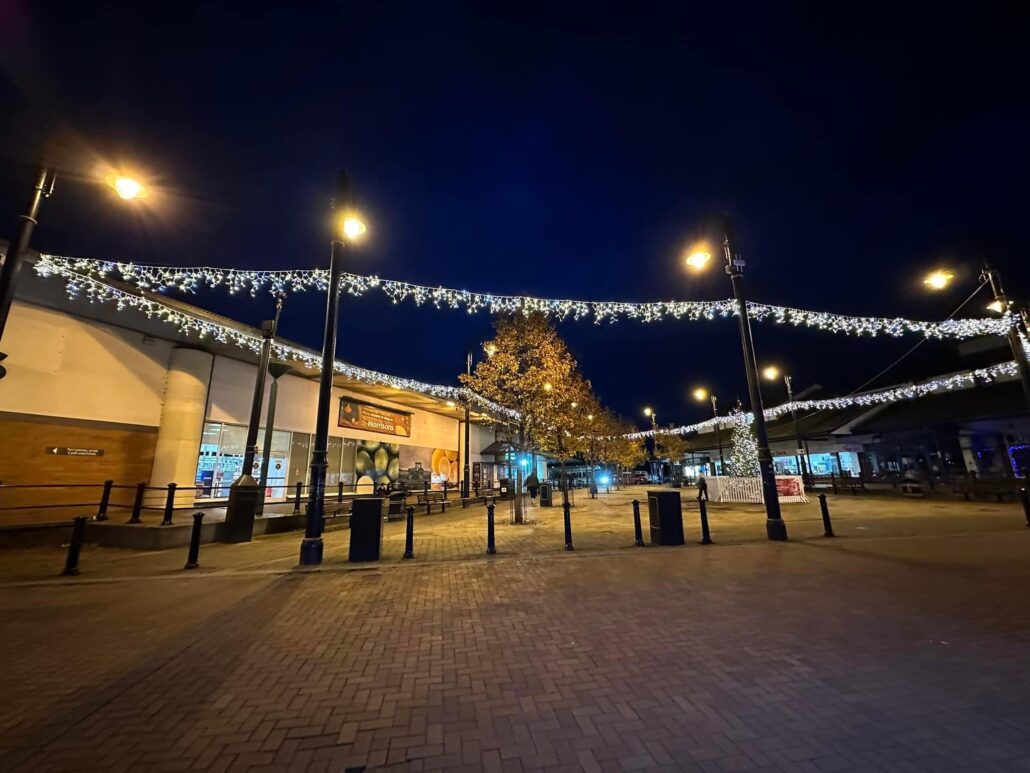
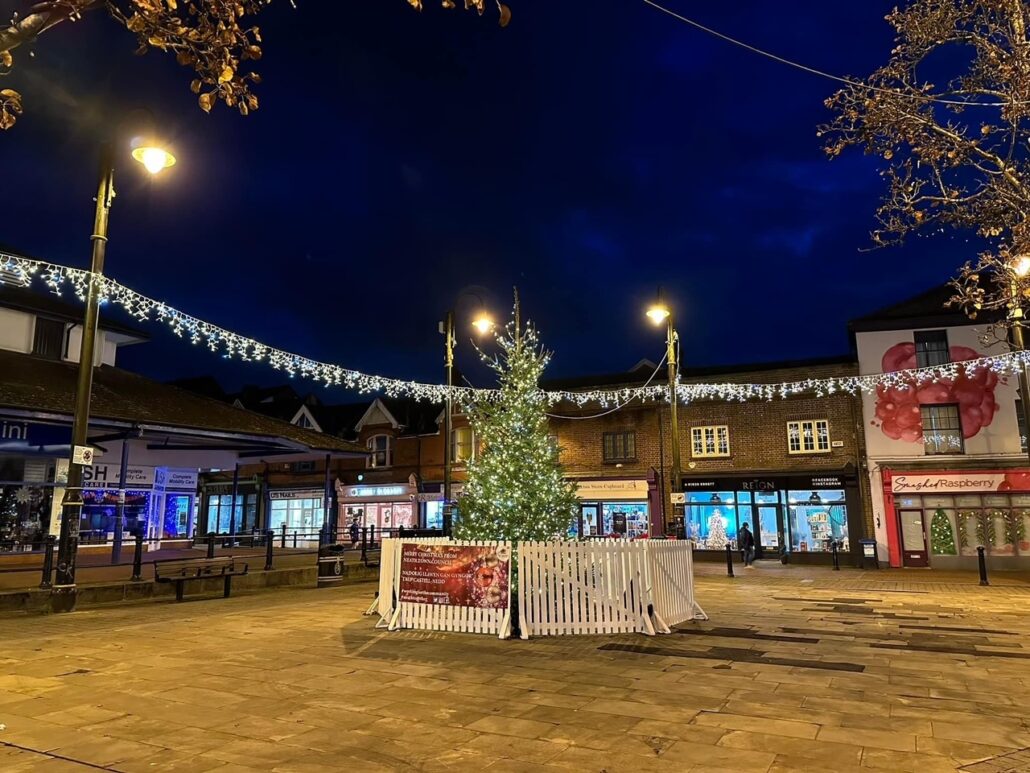
IMAGES BY RUTH DAVIES (Mike’s daughter)
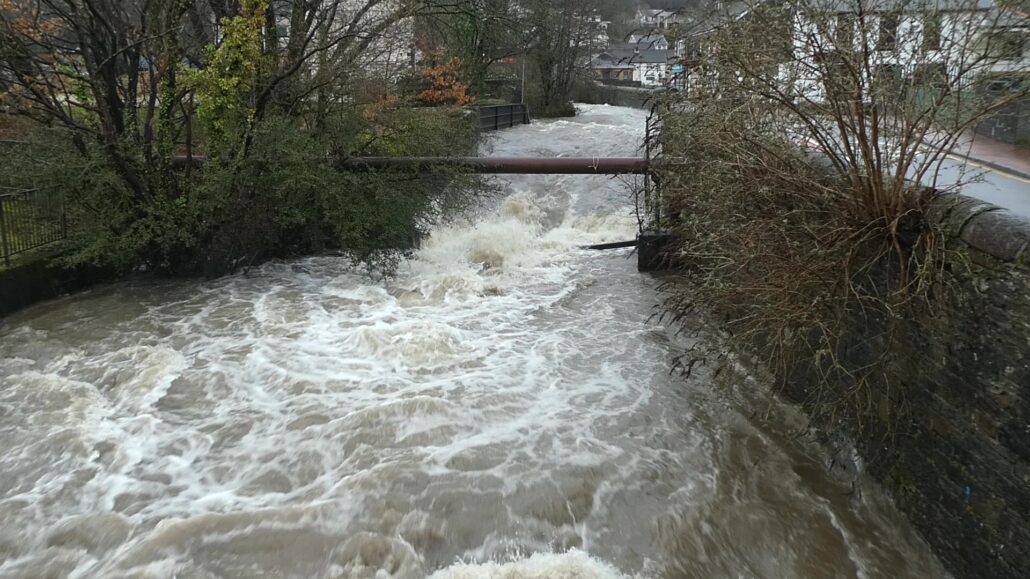
CLYDACH BROOK
I must firstly thank all the people who thanked me for the recent comments of mine on RDN about the state of the Clydach Brook wall. I was also shown a section of the wall behind the Indian restaurant that has totally collapsed and been washed away. .I’m pleased to see a great response from Councillor Dean Lewis and let us hope the much needed work goes ahead.
As for having to provide evidence that the low level of the bridge has caused flooding in the past ,we should not be concerned about the past but trying to protect the village from potential flooding due to completely different heavy rains that we see affecting the whole of the country .
£!.7 million Valleys and Villages Prosperity Fund
I read with interest the fact that there is a 1.7 million pounds Fund that can be applied for a list of things. .I think this is a great opportunity for our Community Council to apply for funding on a number of projects that I think would benefit the people of the village.
Number one would be for people that have to use wheelchairs or disability scooters and mothers with pushchairs to be able to have the same access as the rest of of us.. By this I mean ramps- disabled ramps constructed at the bridge where the wall has collapsed. This would be of great benefit to a lot of residents. The only way to get from one side of the bridge to the other if you have a scooter is to go all the way round passed the Chemist (how nice if it’s raining).
Number two is along the same lines-for ease of access. .I can’t for the life of me think why we should put up with that monstrosity of a railway bridge at the top of Rugby Road and the obstacle it causes to people especially the ones I have just mentioned. (Only less than a mile away by the cemetery there are two gates to open to cross the line there.) .
If the railway bridge in the village can’t be removed, let’s have two gates and a footpath put there. I am sure the people crossing the path would look out for the one train we might get every 20 years or so.!!
Number three would be be the tarmacking of Woodlands Terrace and Nant- y-Gleisiad These roads are in a terrible state of repair. In the past the council say they can’t surface them because they are private roads. The residents of these roads pay the same rates as the rest of us so I see no reason why they should not have a decent road to walk along. Many years ago the lane from the Scout.Hut to the railway bridge was tarmacked so it can be done
.These are just a few things that I would like to see done.
So, come on people of Resolven !
Put your ideas forward before Glynneath gets all the money.
Regards
J.R. Geary
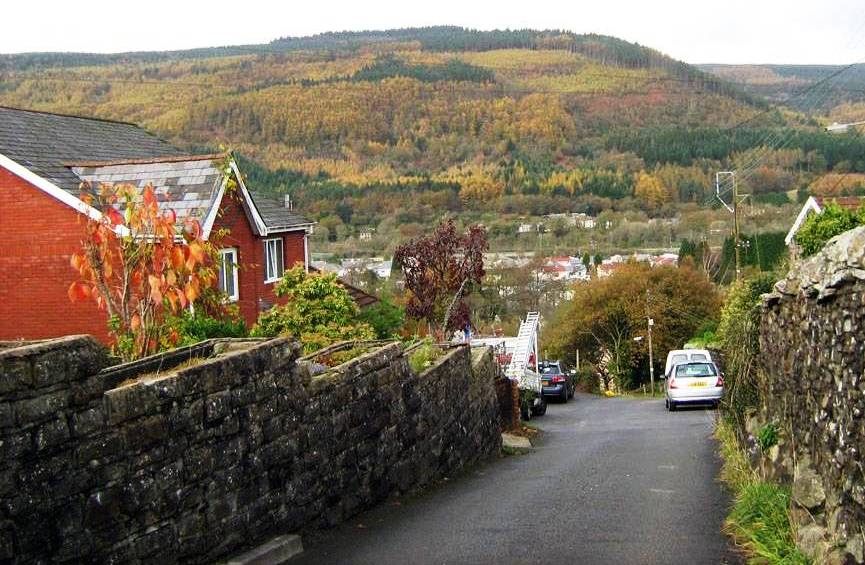
Resolven view from Pentwyn Hill
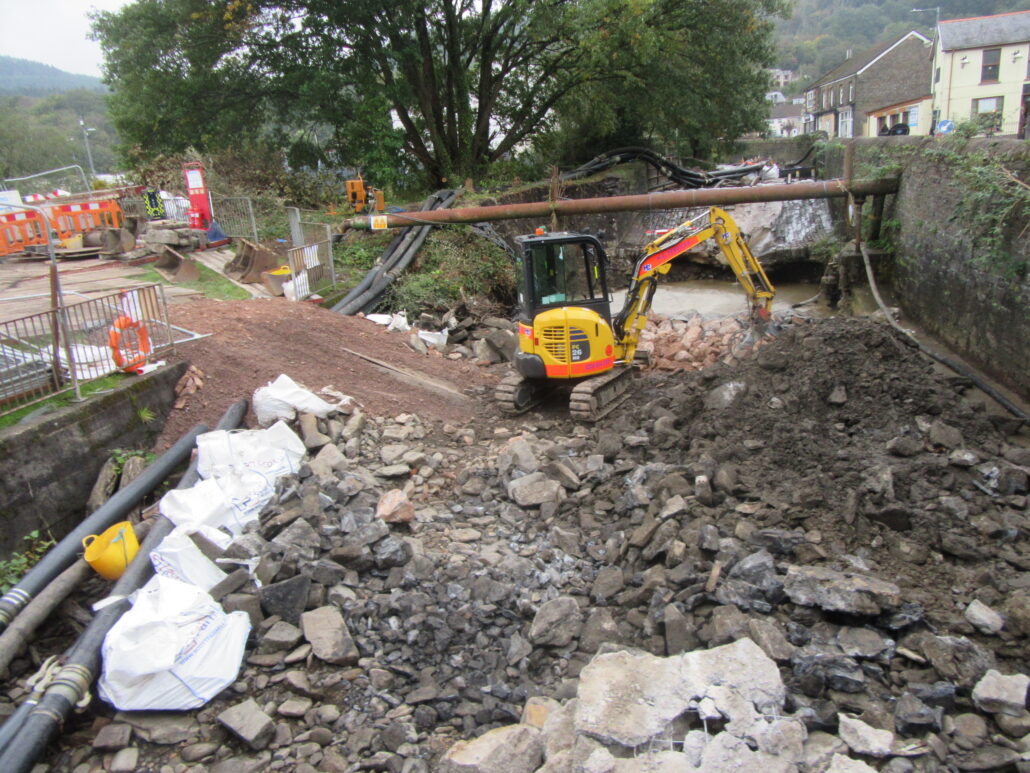
.
Message from Councillor Dean Lewis
-Below is the update I requested last week from NPT officers
“The preliminary repairs have been undertaken by NWRs contractor and our Engineers have been on site to monitor the works. The void under the wall has been filled but there is more work to be done on the spillway.
The contractor is starting to pull off site as they haven’t been able to do much work over the last couple of weeks due to water levels. The plan is for them to come back in April to finish off the works.
With regards to the wall itself we have asked the contractor to undertake some devegetation works which they have partially completed but they will finish on their return. We will also look to undertake some repointing & rebidding of any loose stones after the main works have been completed.
Before NWR complete their works on site we will undertake a full structural survey to make sure nothing is missed.
With regards to raising the height of the steel parapet this will have to be raised with Network Rail as they own the bridge. If they are willing to raise the parapet and they have funding they will need to get permission from CADW as it is a grade II listed structure. This may be problematical from dealing we have had with CADW regarding our own structures. As part of the evidence we will have to supply documentation to prove that the river has over topped at this location and caused flooding.”
A Report on the November meeting of Resolven History Society
November often proves a dismal month and it is no surprise that many cultures respond by firework displays to dispel the dark evenings before Christmas decorations illuminate the scene. Indeed , the weather has been so inclement that an occasional Christmas tree was in a window as the last of Guy’s fireworks rained down. On a rather wet evening a small but interested group came together to hear Mr Keith Tucker of Neath Antiquarians , conclude his pictorial tour of Neath and its environs through a historical lens.
Mr Tucker began with a photograph of local industrialist and early photographer, Dillwyn Llewelyn, who along with the Fox Talbot’s of Margam, was among the early developers of photography. He then took the audience on a fascinating tour of Neath and its vale, with photos emanating from the quite recent to the 1890s. Inevitably, the audience tried to add to the explanations of Mr Tucker and they were frequently incorrect or inspired, in turn.
Before the commencement of his talk, Mr Tucker explained that it was currently the centenary of Neath Antiquarians. To celebrate, they had produced an immense tome titled the “The Neath Antiquarian, Volume IV”. The cost of the book which runs to over 500 pages was huge, but with the help of a local authority grant, this was reduced greatly and would be a fabulous Christmas present, especially as it is a limited edition of only 300 copies. It is available from the Mechanics Institute in Neath .
Mr David Woodham thanked Mr Tucker for a memorable talk, and hoped he would return in the future to address the Society.
Trefor Jones.
~ ~ ~ ~
The Annual Service of Remembrance is held to pay tribute to all those who gave their lives serving their Country. The 2023 Service, organised by Resolven Community Council, was conducted for the first time by the Rev. Julian Jenkins, who is a retired Clergy.
The Service was held at 10.30am at the St David’s Church Hall in the centre of the village.
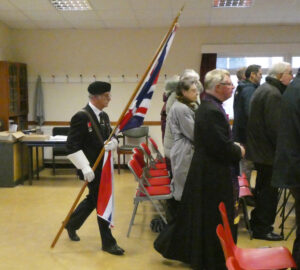
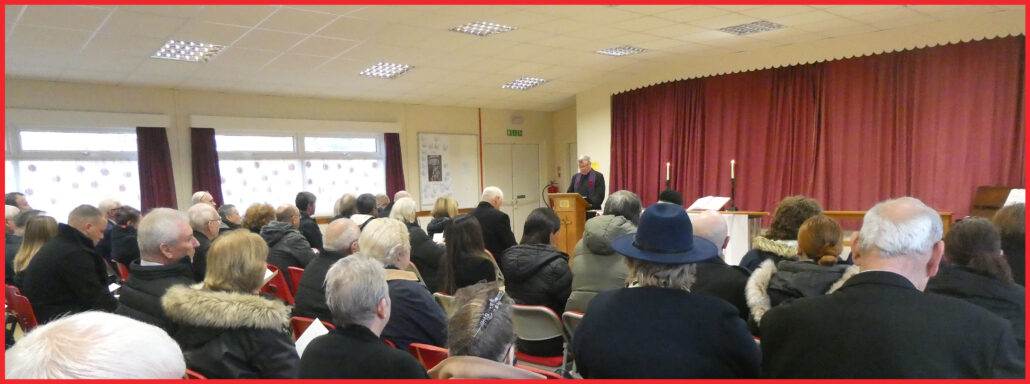
After the short service inside the Church Hall, the congregation moved outside to continue the Remembrance service, joining a large crowd who, despite the rain, had gathered around the War Memorial.
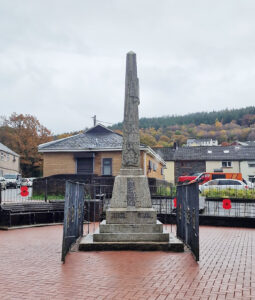

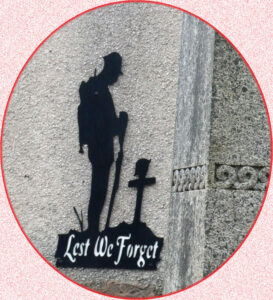
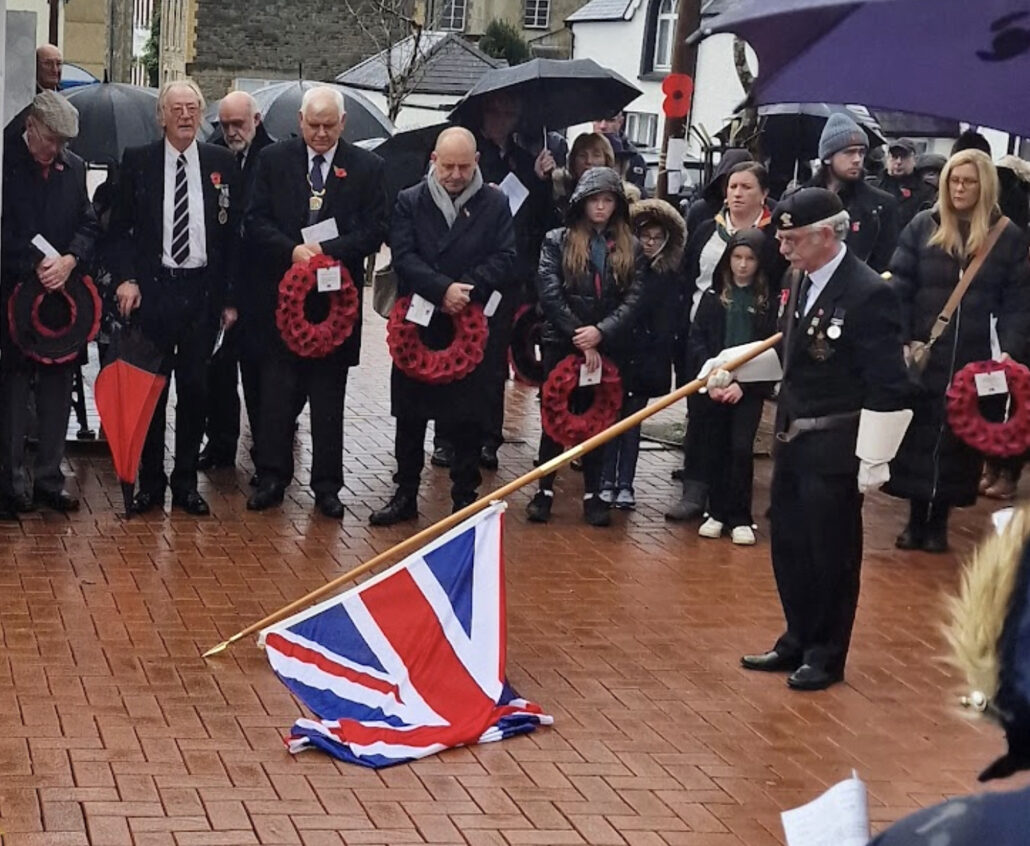
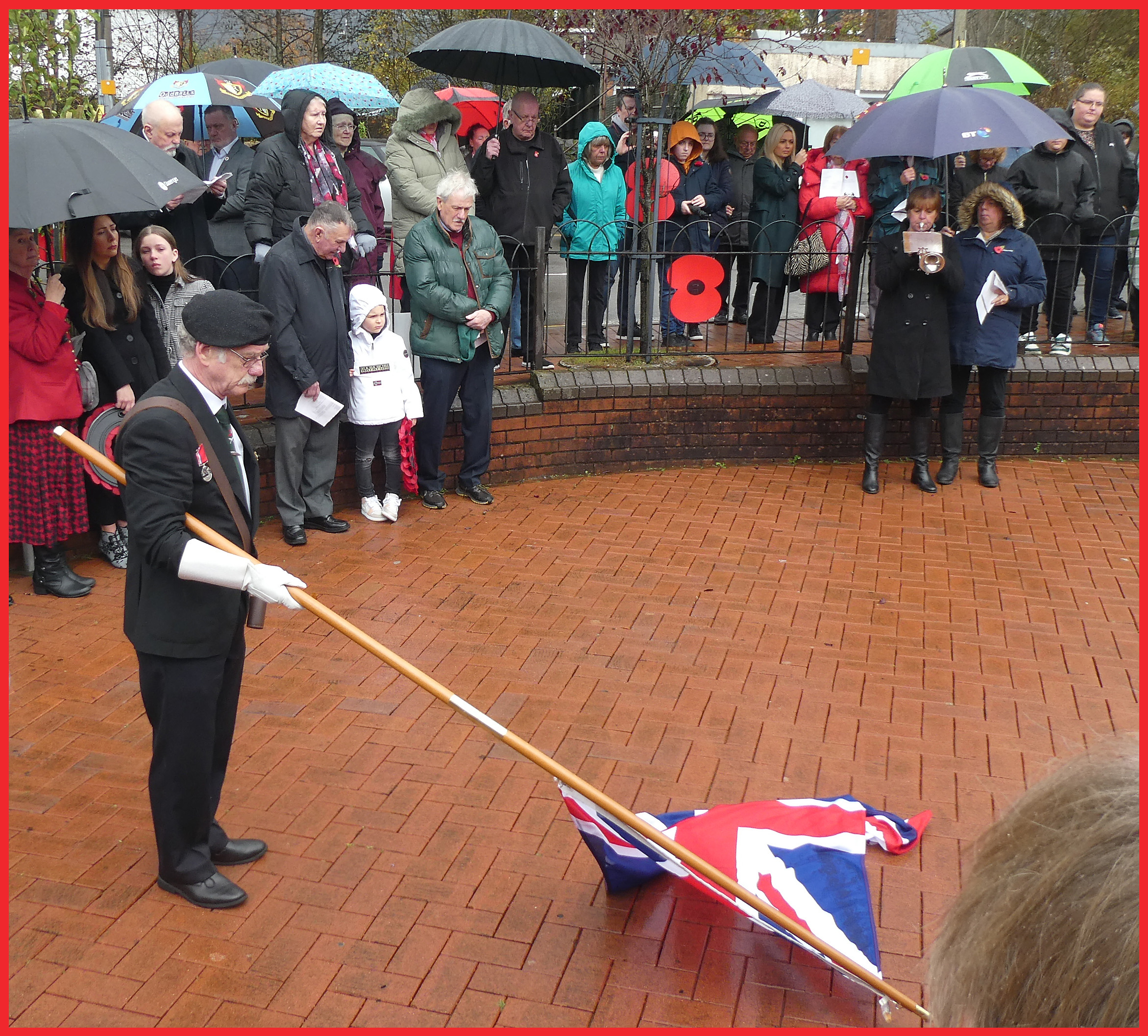
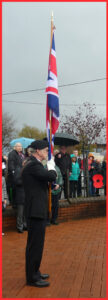
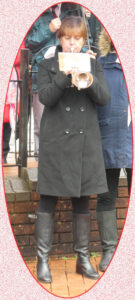
Ms Karen Cartlidge has played the ‘Last Post’ at the Resolven and the Clyne Remembrance Services for over 40 years and had again, this year, travelled a long distance to do so.

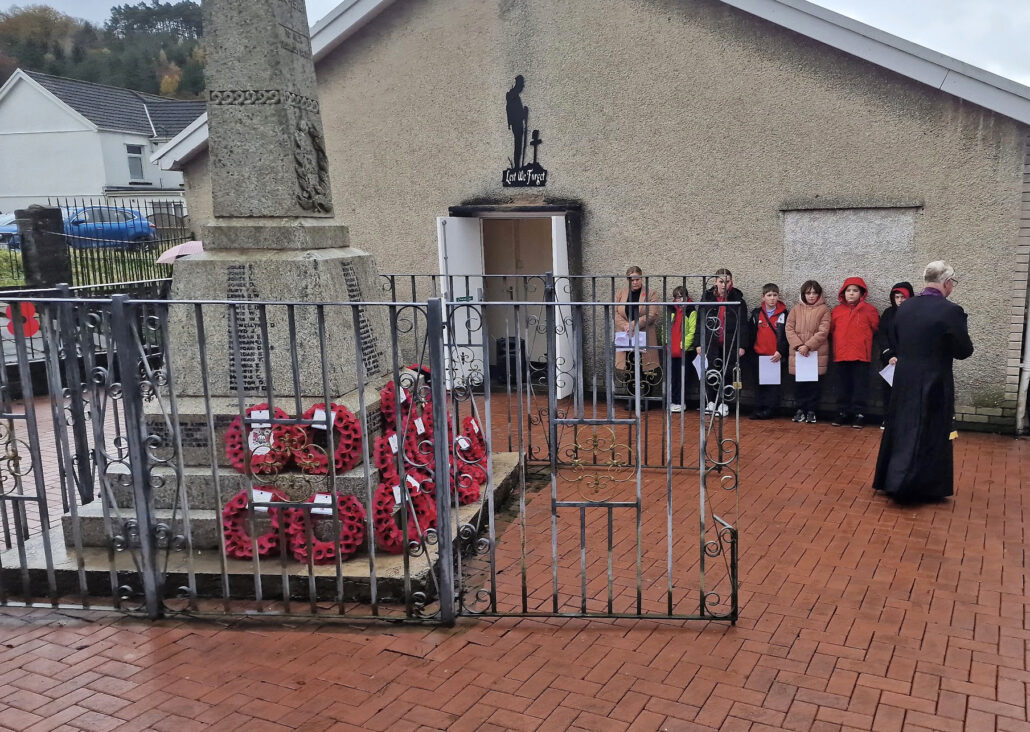
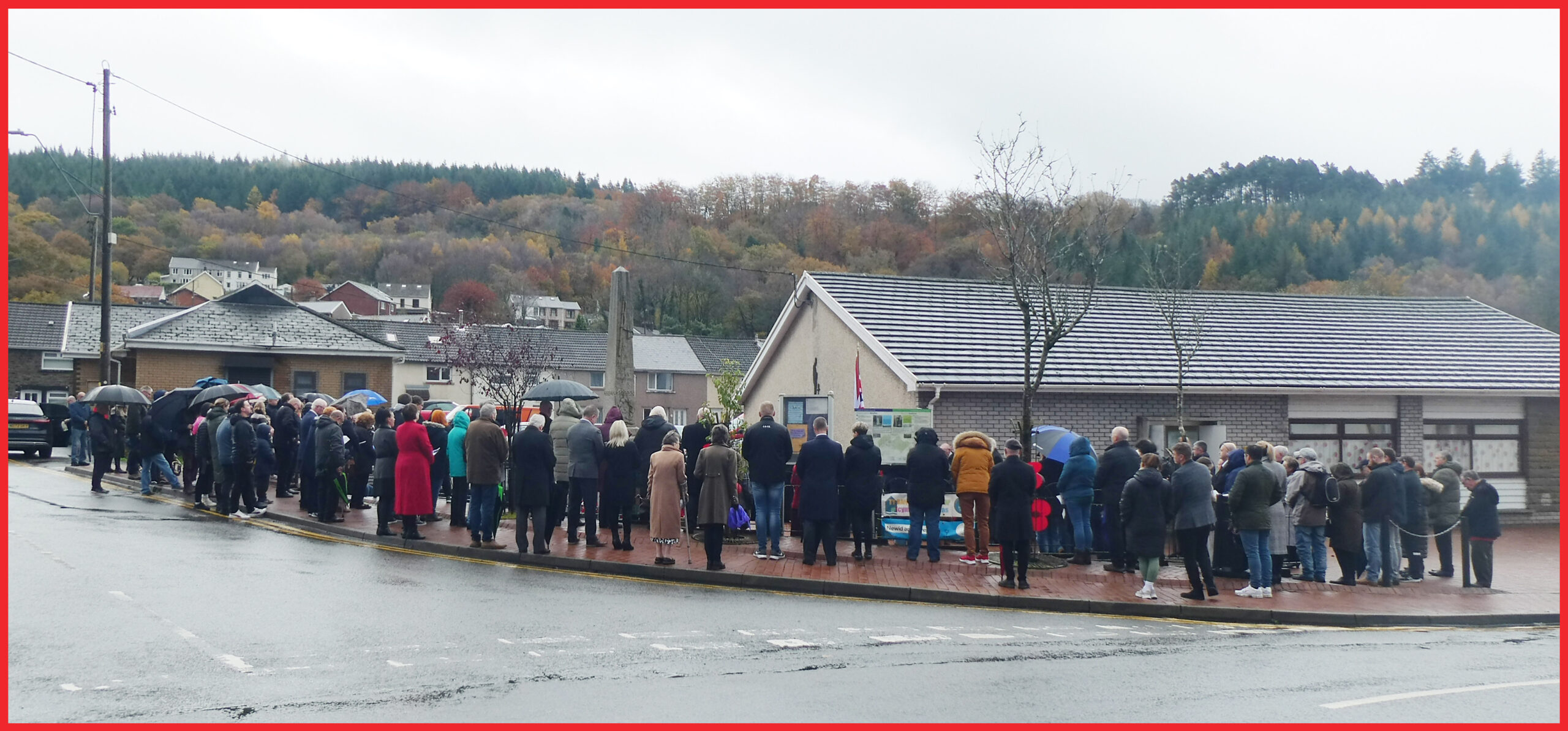
~ ~
Photographs at Resolven taken by Hugh Lewis, Natasha Williams and Mahmet Ali Mavis
~ ~ ~
The Remembrance Service at Clyne was held at 12.00 midday
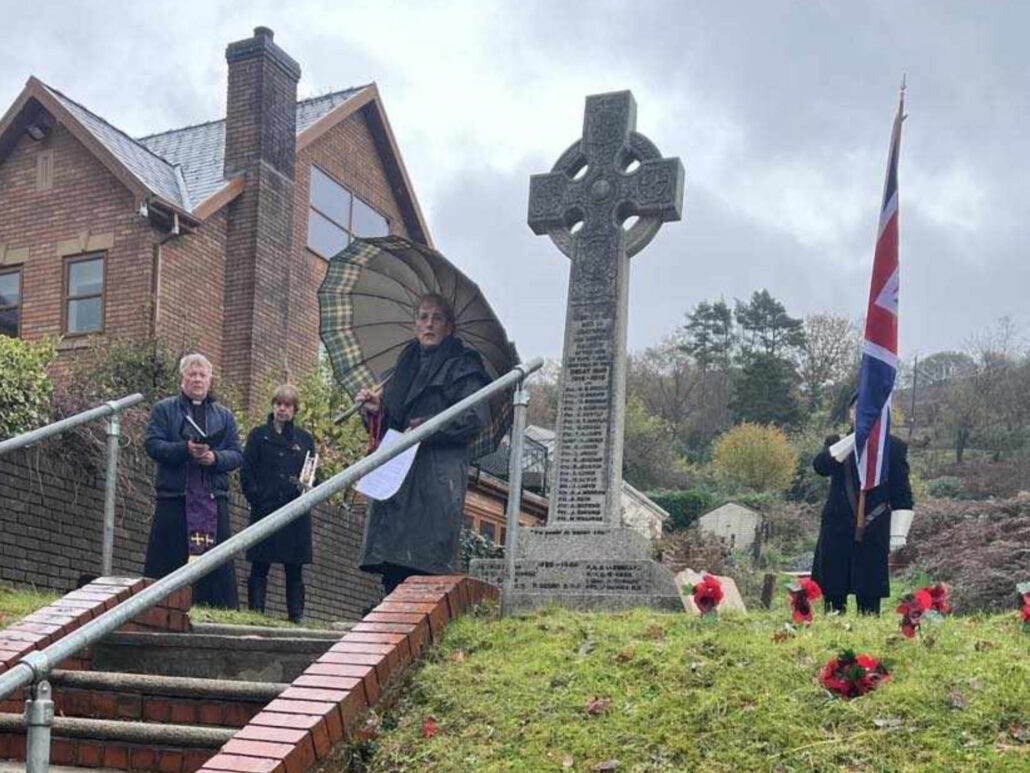
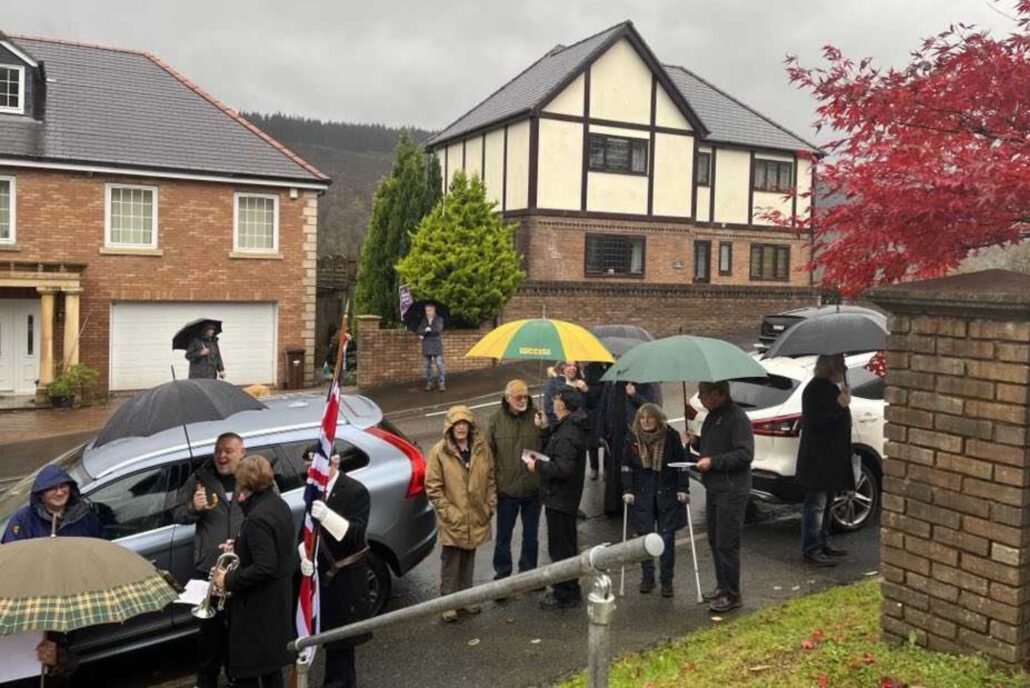
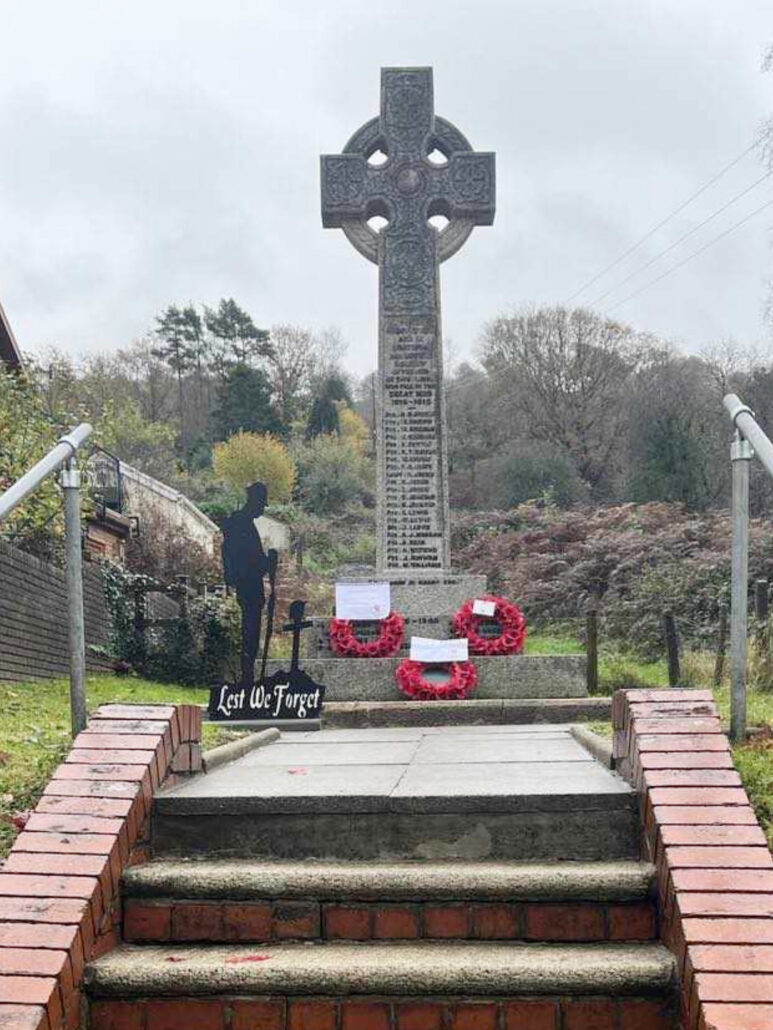
~
They shall grow not old, as we that are left grow old:
Age shall not weary them nor the years condemn.
At the going down of the sun and in the morning
We will remember them.
~ ~ ~ ~
01 November 2023
The UK SPF Valleys and Villages Prosperity Fund ‘Open Call for Projects’ is now live – £1.7m funding programme to revitalise Neath Port Talbot’s valleys and villages is now open – NPT News.
~
NEATH Port Talbot Council is inviting project proposals to its Valleys and Villages Prosperity Fund (VVPF).

The £1.7m VVPF is part funded by the UK Government’s Shared Prosperity Fund (SPF) and is part of Neath Port Talbot’s £27.3m SPF funding allocation over the next three years.
The VVPF aims to address the decline in rural communities throughout Neath Port Talbot, particularly the reduced demand for high street retail and increased demand for housing, recreational and active travel projects.
Targeted areas include the Neath Valley, Afan Valley, Swansea Valley, Upper Amman Valley and Dulais Valley.
The VVPF aims to have a positive impact on key issues for the county borough including job creation, health and wellbeing, pride of place and economic growth.
The deadline for expressions of interest is 31st December 2023 and all projects must be completed by 31st December 2024. Applicants can apply for up to 70% of their total, eligible project costs, up to a maximum of £250,000.
Project proposals could include:
Potential applicants can find more information, including the VVPF Applicant Guidance and an Expression of Interest Form on this webpage – UK Shared Prosperity Fund: Open Call for Applications to the Valleys and Villages Prosperity Fund (VVPF) – Neath Port Talbot Council (npt.gov.uk)
For an informal discussion on any project proposals, please email regeneration@npt.gov.uk or telephone 01639 686073.
The VVPF has been established as part of the UK Shared Prosperity Fund to target areas of Neath Port Talbot which do not fall into other funding categories such as the Welsh Government’s Transforming Towns initiative.
Cllr Jeremy Hurley, Neath Port Talbot Council’s Cabinet Member for Climate Change and Economic Growth, said: “The VVPF will bridge the gap in funding across the county borough so people are not missing out on funding opportunities.
“It will make a big contribution to the improvement of the valleys and villages areas of Neath Port Talbot, making them a better place to live and work. It will also help meet the demand for commercial and residential units in areas where these are wanted.
“The VVPF will directly support the delivery of the council’s Wellbeing Objectives as well as the Wellbeing of Future Generations Act. Under this scheme, our valley communities will benefit from improvements made to their villages, that will help with the creation of new local jobs and an improved perception of place.”
Potential applicants who will be eligible to apply for grant funding for their project proposals will include owners of vacant commercial premises, land owners, town and community councils, local authorities, business improvement districts, and social businesses.
~ ~ ~ ~
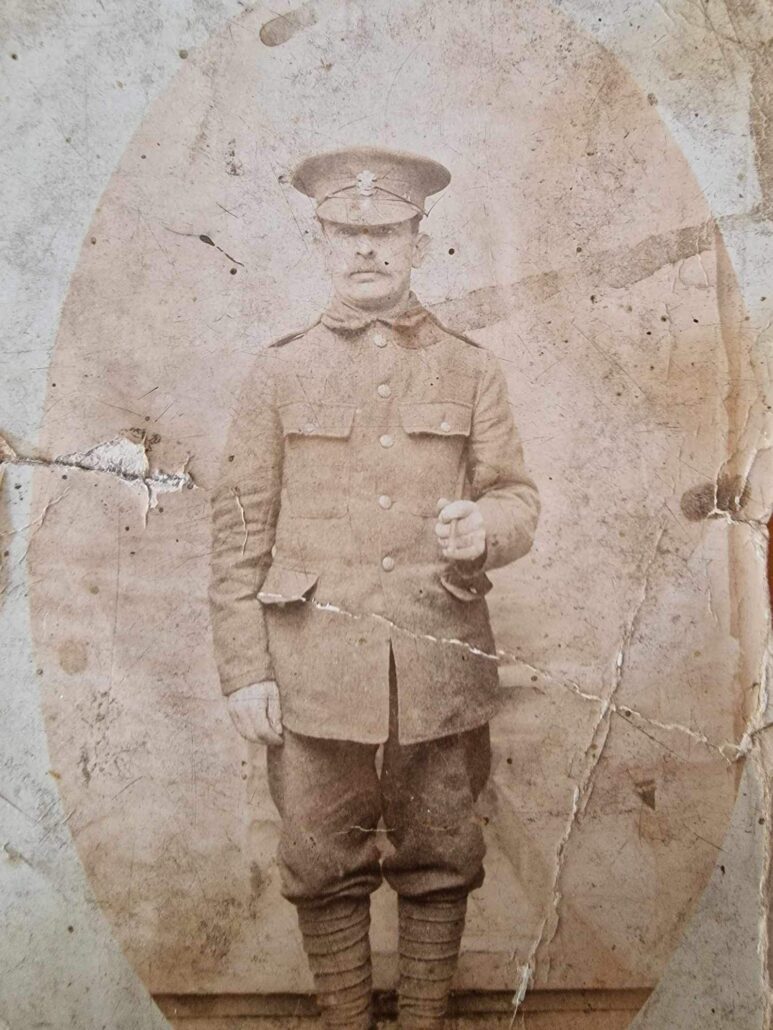

Hello!
My great-grandfather is first right in the second row in the group picture
I believe his name was Griffith Waters, he was born in 1874 and died in 1932, he lived at 43 company street along with his wife Susannah Howells ( a native to Resolven) and their 10 kids Mark, Thomas William, Hannah, Lucy, Hedwell, Stanley, Miriam, Agnes and Mary ann.,
He served in the South Wales Borderers However, ended up getting gassed whilst fighting and being pushed back to the Labour Corps,
I believe I only own the one photograph and now the one you uploaded with him in, however it would be lovely to see if their are any other photographs of him and his family?
ASHTON TAYLOR
EDITOR It would be great if you could help Ashton add to his family story.
—send to us at RDN
Also,, with Remembrance Sunday coming soon, we would like to show any picures you may have of your own family serving in the Armed Forces over the years
Response from a concerned and worried resident regarding Clydach Brook Retaining Wall
“I can’t believe the destruction the latest storms have brought to parts of the UK in the last couple of weeks. I can’t imagine my home being under feet of dirty water and the devastation it must cause. Which brings me to the subject of this letter.
We have in this village one vital piece of infrastructure that protects about 80% of the houses from the devastation of being flooded and that is the old stone wall in front of what was the Vaughans pub. Quite some time ago there was a meeting held in the Church Hall to tell the people of Resolven that there was to be money spent on flood prevention and they detailed the work that they were going to carry out. This work was to include a new wall outside the houses of Ardwyn Terrace, an extra course of stonework on top of the existing stone wall and lifting the steel structure that forms the railway bridge.
I suggested in that meeting that there was no wall on the other side of the cost cutter store and so this was added to the list of work to be done. That wall was built of a single brick thick and was a couple of months later partly knocked over and had never been replaced.
The old stone wall was made higher, and as for the steel structure, the bolts to hold it in place are still there for all to see but where is the steel.
All this information brings me back to the main subject which is the old stone wall and it’s condition. Anyone with a knowledge of building will tell you that the wall will get weaker with age and that wall has been there a long time. I read an article by Councillor Dean Lewis in which he states that he had been informed that the wall on the roadside is in good condition. I would suggest he goes and look for himself that there are trees growing out of the wall all along it’s length. I can’t imagine the damage the roots are doing. The wall is in a terrible state of repair, look back at the photos on this very site to see the water going down Commercial Road.
We should be doing everything we can to prevent this happening again, the warning signs in the collapse of part of this old structure should not be ignored.
In closing, I would suggest this most important structure be inspected by independent engineers and the results published on this site.”
Regards
J R Geary
~ ~ ~ ~

~
The following two Photographs taken of the cascade and aqueduct before the retaining wall collapse.
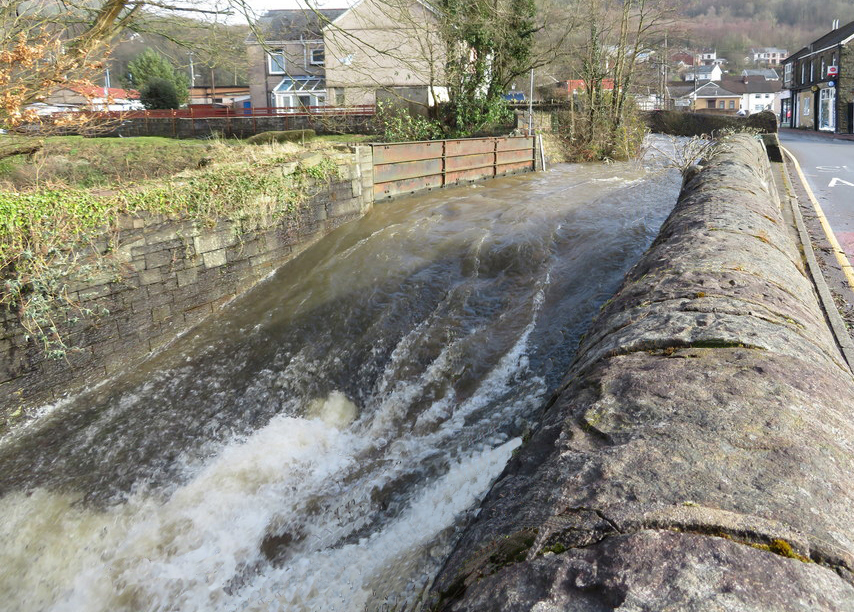

~
On Sunday 24th September 2023, after an autumn storm and heavy rain, the familiar sight and sounds of the free flowing Clydach Brook suffered some alarming damage and was seriously affected by part of the North East retaining wall dislodging and collapsing into the water. It had looked precarious for several months.
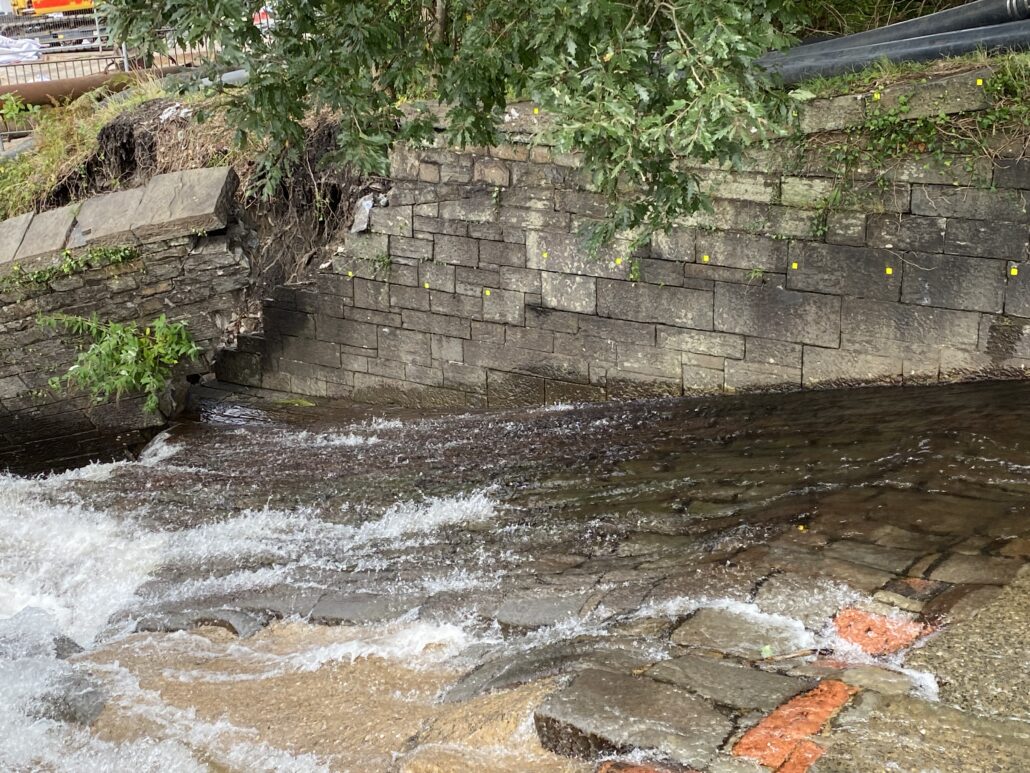
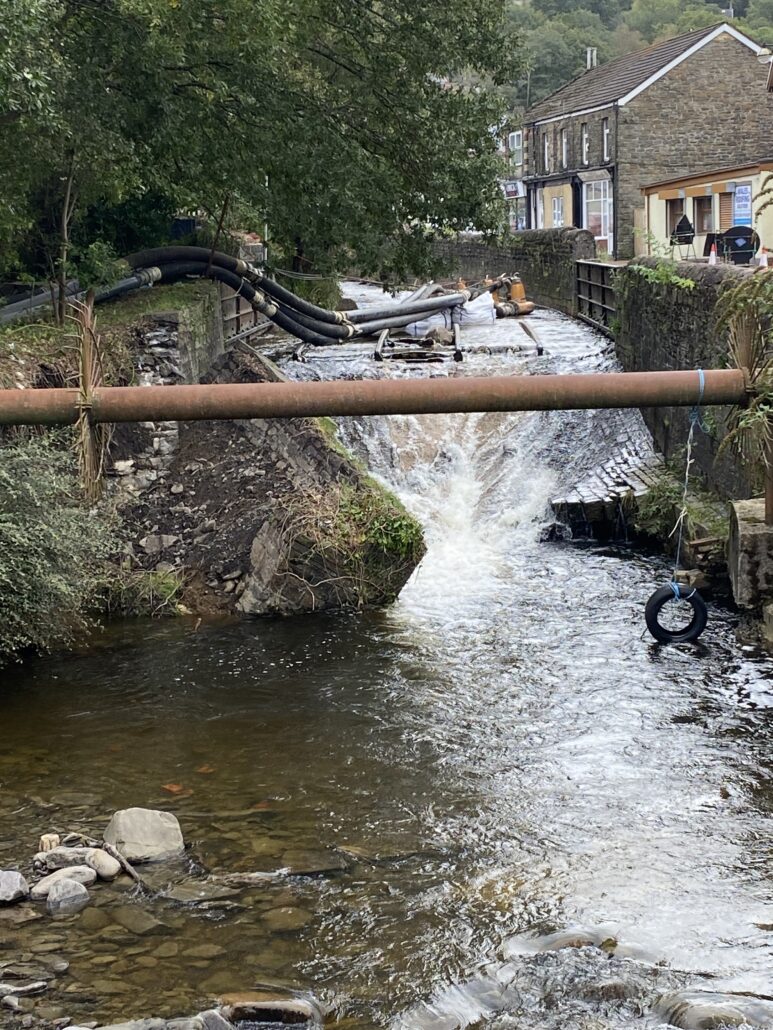
The Aqueduct is quite unique in its construction. Designed by the renowned Victorian Engineer, Isambard Kingdom Brunel, and built by George Hennet Bridgewater Ironworks whose name is stamped on the panelled sides on the NE Side.
It is a substantial cast iron structure carrying the Clydach Brook over the Vale of Neath Railway, which was opened in 1851.
It is situated alongside and parallel to the main B4343 Commercial Road through the centre of the village of Resolven. Brunel altered the levels of the waterway and from the road it can be seen that the levels change dramatically producing a cascade which is spectacular when there is a huge torrent of water. Brunel also added in-line rails on the aqueduct, to help with the flow of water which is clearly visible when the water level is low.
The aqueduct was designated as a Grade II listed building in 2003 and ‘CADW’ is involved in its repair and restoration.
.
Report from Cllr. Dean Lewis on the situation.
“I have been in contact with the Council and their Engineers for quite some time to discuss the poor state of the stonework in the Clydach Brook. It isn’t a Council asset and responsibility did not come under our umbrella/assets. As you may be aware the stonework is graded and as such is protected by Law. CADW were contacted and asked to get involved as progress was slow in protecting the site for future generations.”
“After many, many months of negotiations work was meant to start on Phase 1 of the project by Network Rail and NRW to make the area safe, on the very day contractors turned up the wall had collapsed hours before. Luckily it happened before workers made it to site and nobody was hurt. Phase 2 of the project will see the stonework and walls reinstated and put back to how it was. I haven’t had conformation when Phase 2 will start but I will keep you informed as and when I get the information.”
“I have also been informed after airing my concerns to engineers that the roadside wall is in good condition and no deterioration has occurred.”
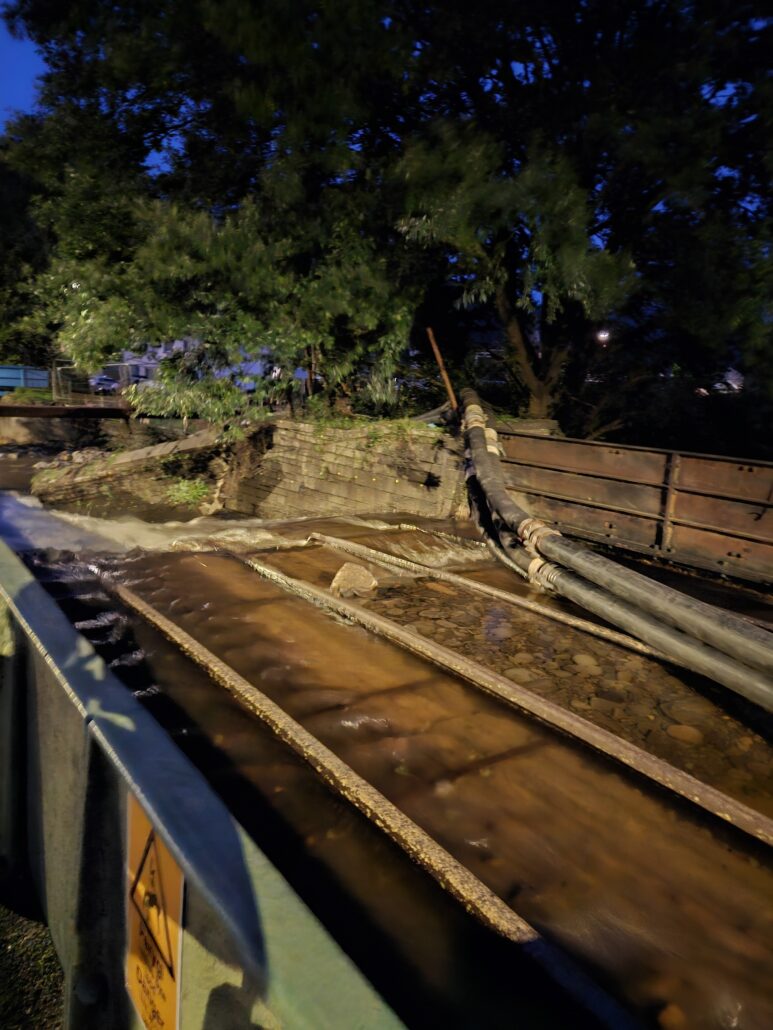
These two photo’s show the pipes diverting the water away from the original water course to enable work to be done.
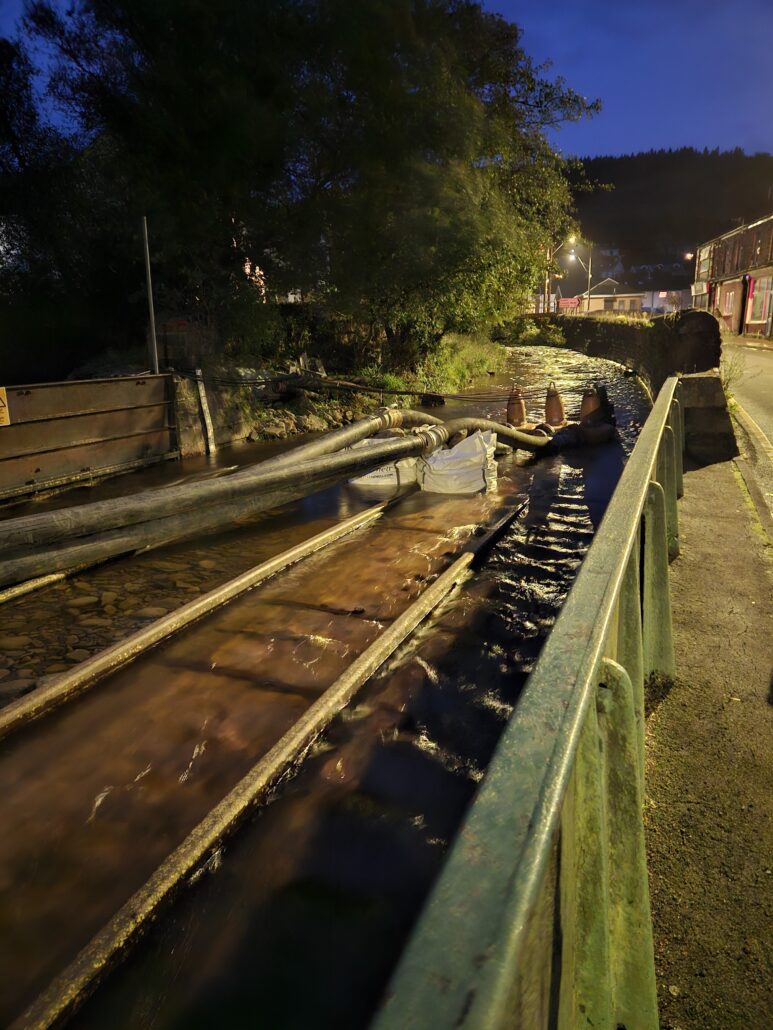
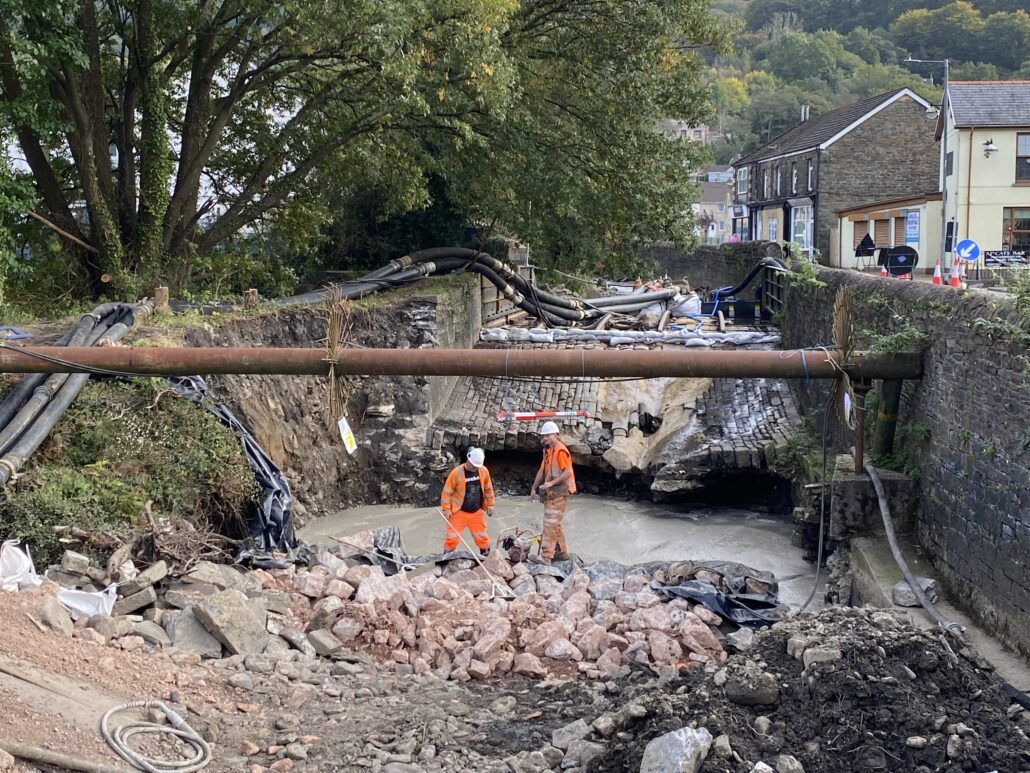
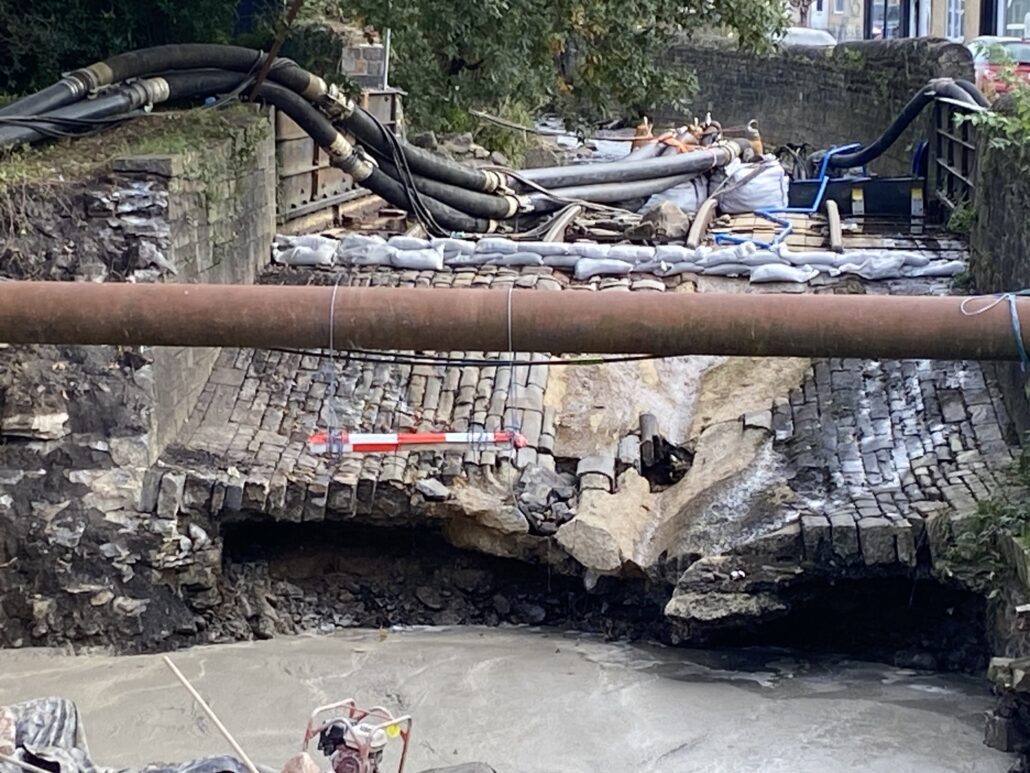
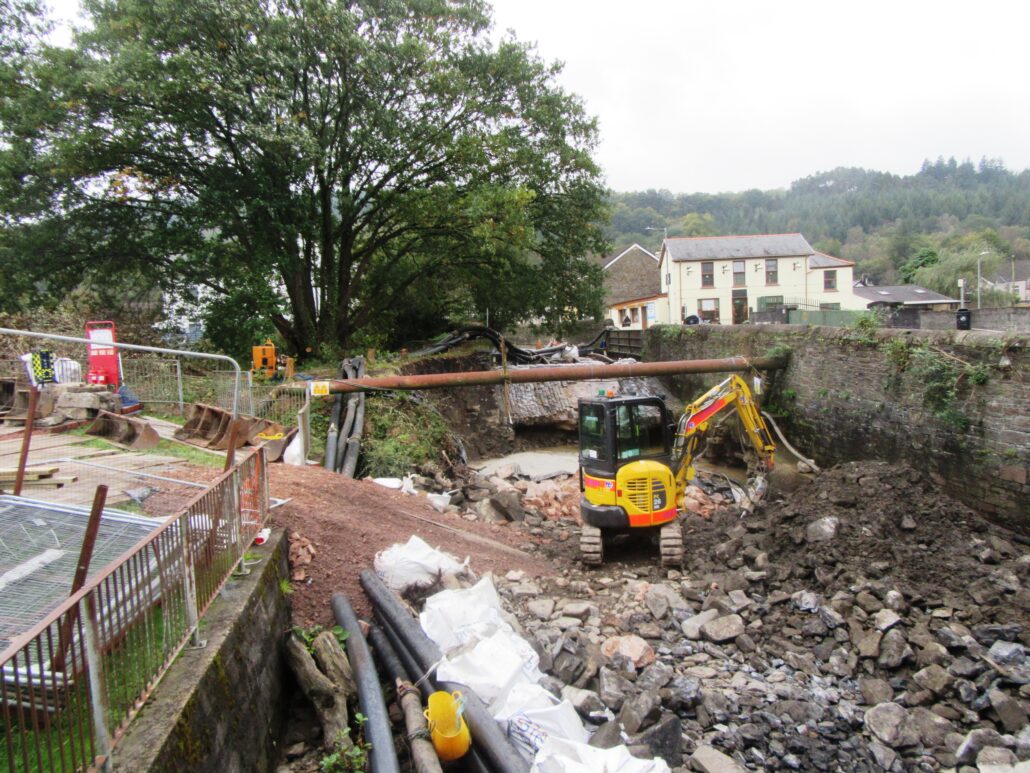
It is obvious from the above photographs that there is a vast amount of work to be done to bring this structure back to its former glory.
~ ~
Report by H & L Lewis
~ ~ ~ ~
